
はならずよんで
ね!
第三帝国における人種衛生学/優生学
Racial Hygiene in the Third Reich, Rassenhygiene im Dritten Reich
Collection bus for killing
patients, during the Nazi regime, Aktion
14f13用の移送バス(Tötungsanstalt Schloss Hartheim)
◎【前史】「人種衛生学
(Rassenhygiene)」用
語の起源と定義(→「各国別比較:優生学の年表」「ナチ優生学歴史研究データベース」)
【ナチスドイツの時代とは1933-1945年の
12年間をさす】ナチあるいはナチスとは、国民社会主義ドイツ労働者党(あるいは国家社会主義ドイツ労働者党、ナチス:Nationalsozialistische
Deutsche Arbeiterpartei, NSDAP,
1920-1945)のことで、ナチあるいはナチス時代とは、ヒトラーが政権を掌握した1933年2月28日の緊急大統領令を布告によるワイマール共和国
憲法の停止から1945年6月5日のベルリン宣言までの時期をさす(→「ナチ
年表」参照)。次に人種衛生学はドイツ語の"Rassenhygiene"のことであるが、これは、つねに、ナチスのという形容詞がついて、"die
nationalsozialistische Rassenhygiene"あるいは"NS-Rassenhygiene," すなわち「国民社会主義人種衛生学/国家社会主義人種衛生学/ナチ人種衛生学」と呼ばれるものであ
る(→「人種衛生学」)。"Rassenhygiene"という用語はアルフレッド・プレッツ
(Alfred Ploetz, 196-1940)の1895年の著作、『人種の効率化と弱者の保護(Die Tüchtigkeit
unserer Rasse und der Schutz der Schwachen)』のなかにはじめて登場する。Weiss, Sheila
(1987), Race
Hygiene and National Efficiency: The Eugenics of Wilhelm
Schallmayer. University of California Press.
によると、プレッツとシャルマイヤーの両者の命名だという主張がある。
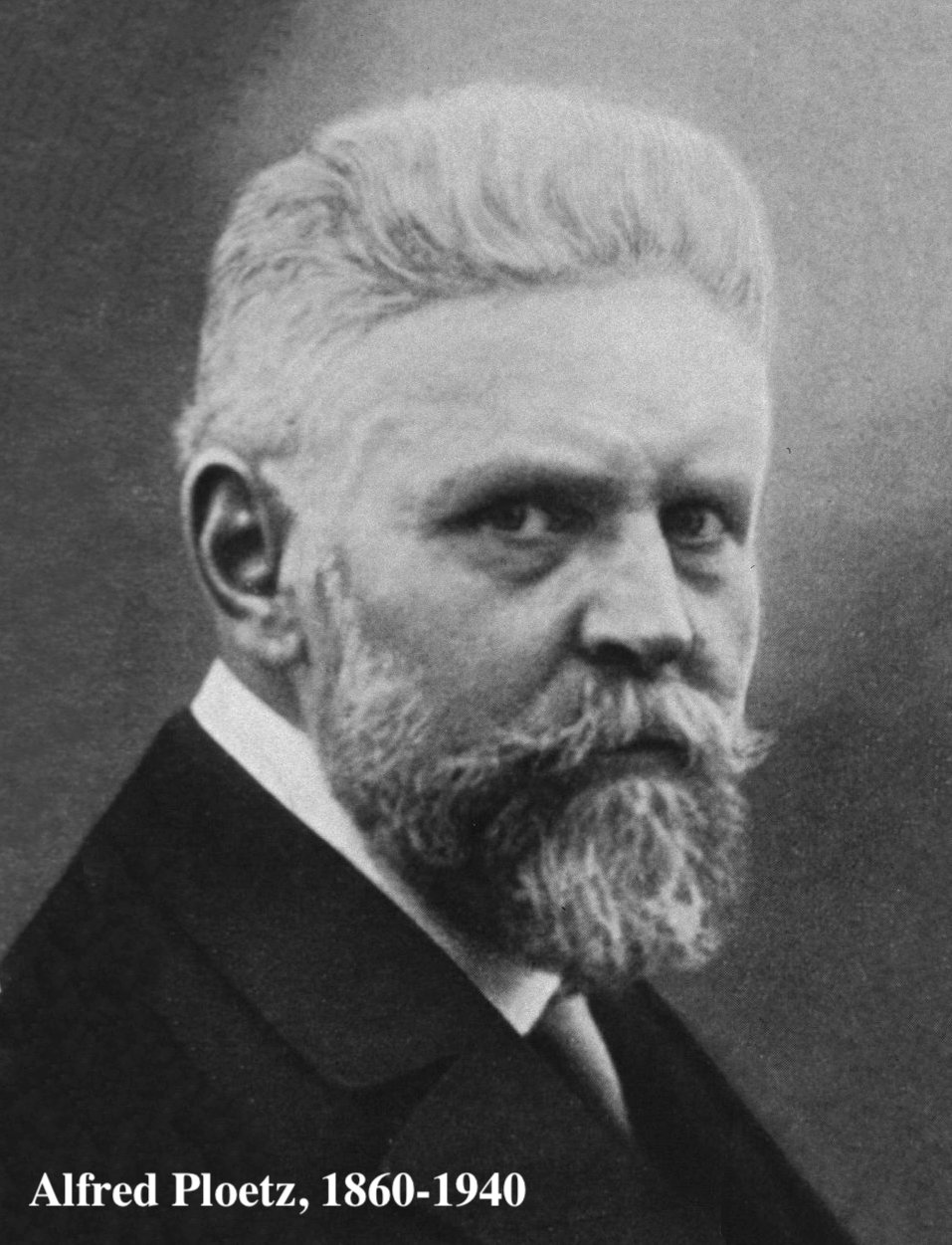
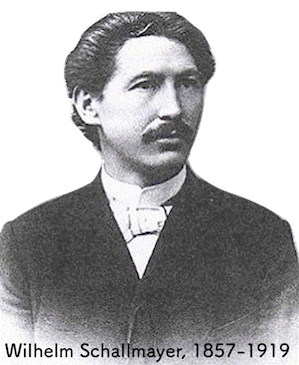
◎【総観】
シーラ・フェイト・ウェイス「ドイツにおける人種衛
生学運動:1904-1945」The wellborn science : eugenics in Germany, France,
Brazil, and Russia / edited by Mark B. Adams, Oxford University
Press , 1990 . - (Monographs on the history and philosophy of
biology)/比較「優生学」史 : 独・仏・伯・露における「良き血筋を作る術」の展開 / マーク・B・アダムズ編著 ;
佐藤雅彦訳, 現代書館 , 1998
はじめに
1. ドイツ流優生学の起源:1890-1903
1-1 ドイツ流優生学をうみだした社会的、職能 的、知的背景
1-2 アルフレート・プレッツ
1-3 ヴィルヘルム・シャルマイヤー
2. ヴィルヘルム帝政期の人種衛生学運動: 1904-1918
2-1 人種衛生学専門雑誌と業界組織の成立
2-2 ヴィルヘルム帝政期のドイツ流優生学の認識 と関心の史的変遷
3. ヴァイマール共和政期のドイツ流優生学: 1918-1933
3-1 フリッツ・レンツ
3-2 ベルリンとミュンヘンの相克
3-3 大恐慌、そして断種・不妊化政策への傾倒
4. ナチス独裁期における優生学:1933- 1945
4-1 強制同化 (Gleichschaltung)と変化
4-2 連続性
4-3 責任と遺産
◎ヒトラーはマディソン・グラ ントや、エルヴィン・バウアー・ オイゲン・フィッシャー・レンツによる共著に感動する
ナチ優生学の誕生にアメリカの動物学者マディソン・グラント (Madison Grant, 1865年11月19日 - 1937年5月30日)による『偉大なる人種の通過(The Passing of the Great Race)』1916年の出版は欠かせない。グラントの著作に、ヒトラー自らが「私 のバイブルである」と手紙をしたためのも、よく知られる話である(キュール 1999:152)。しか し、他方で、グラントによる貢献を大にしてもなお、18世紀末の、人種主義とりわけ、科学的人種主義の思想の欧米知識人への膾炙と、白人優等人種である、 北方人種理論の流行である。(北方人種「理論」は仮説とも呼ばれるが実際には仮説以上の確固たる地位を閉めたので、これは結果的に疑似科学であったが「北 方人種理論」という名声を当時は勝ち得ていたと言っても過言ではない)。以下では、「白人の人種的衰退陰謀論/白人虐殺陰謀論」(White genocide conspiracy theory)の源流としての「ナチの優生学」があるが、それがどのように発達してきたのかを、ウィキ ペディア「ナチスの優生学(Nazi eugenics, 英語版)」をもとに概観する。※関連するページ「各国別比較:優生学の年表」を参照のこと。
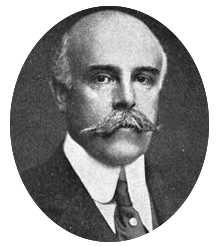
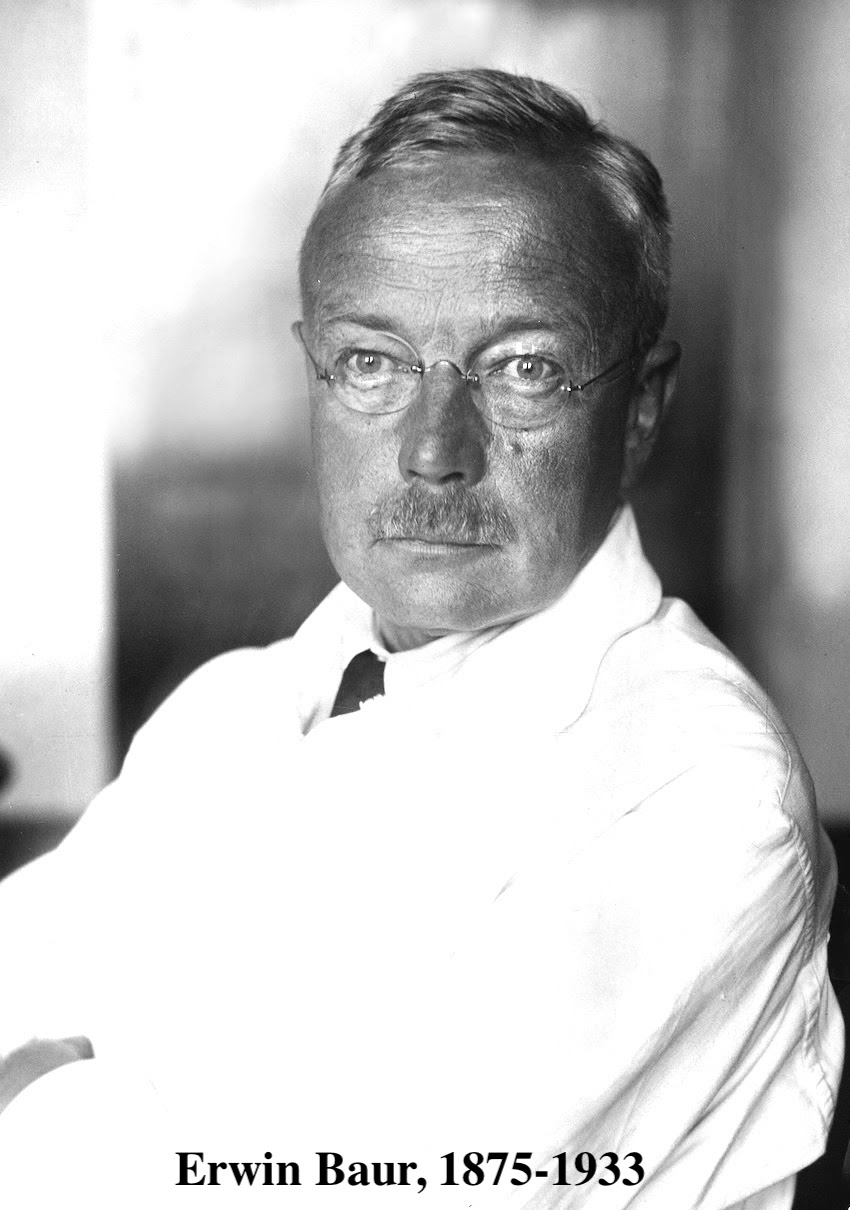
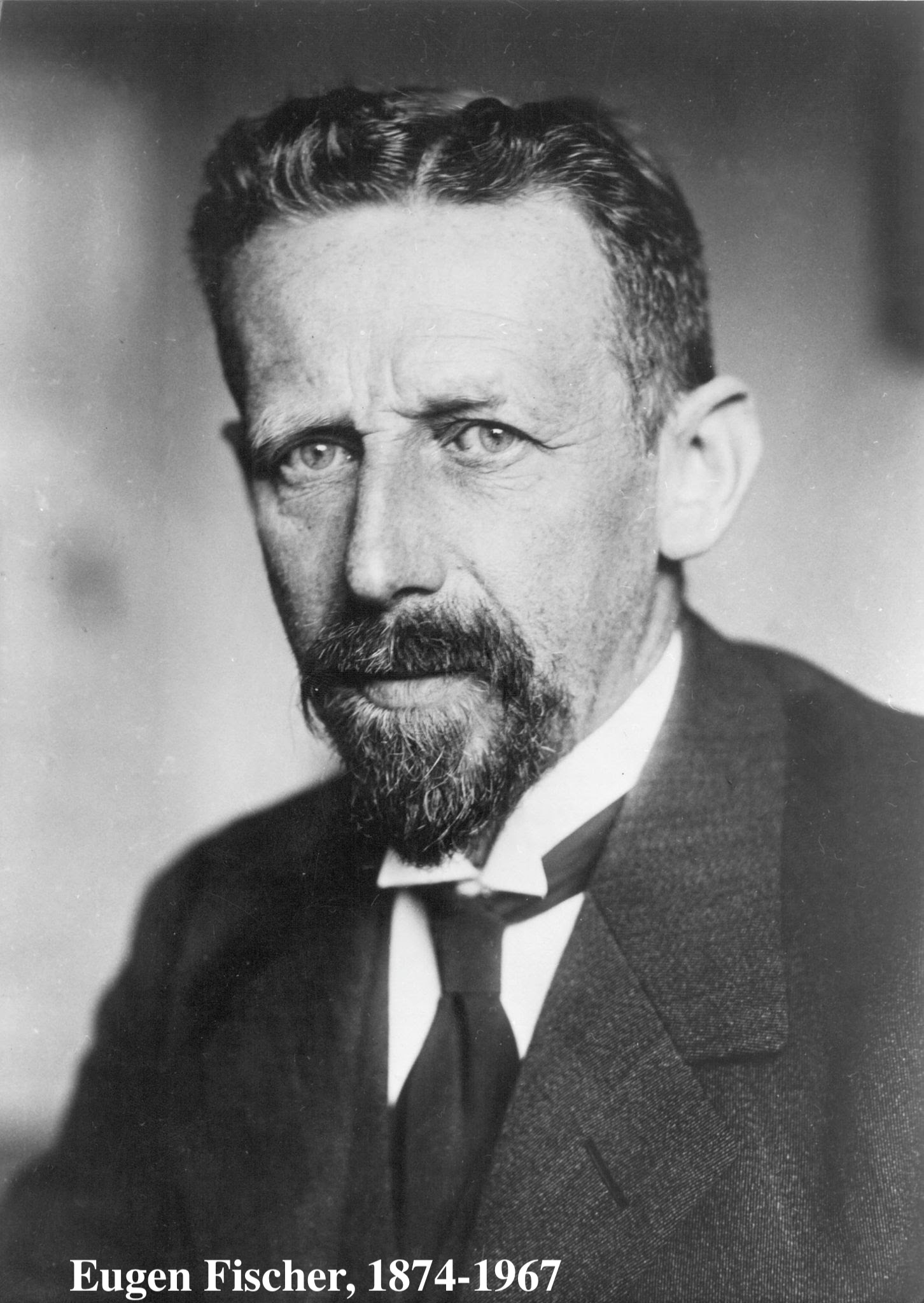
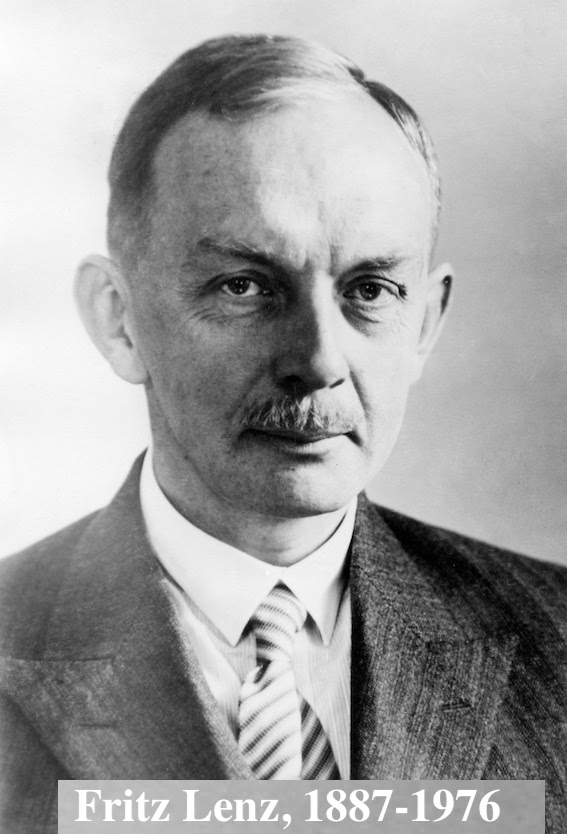
あるいは、ヒトラーはミュンヘン一揆の失敗後に収監 されたランツベルク刑務所で、バウアー・フィッシャー・レンツによる共著『人類遺伝と人種衛生学概論(Grundriß der menschlichen Erblichkeitslehre und Rassenhygiene)』を読んで、遺伝の概念や遺伝の有害因子の排除について興味をもったという。
◎遺伝学・人類学・人種衛生学および優生学の大学教 育機関数の増加--Proctor (1988:38右)
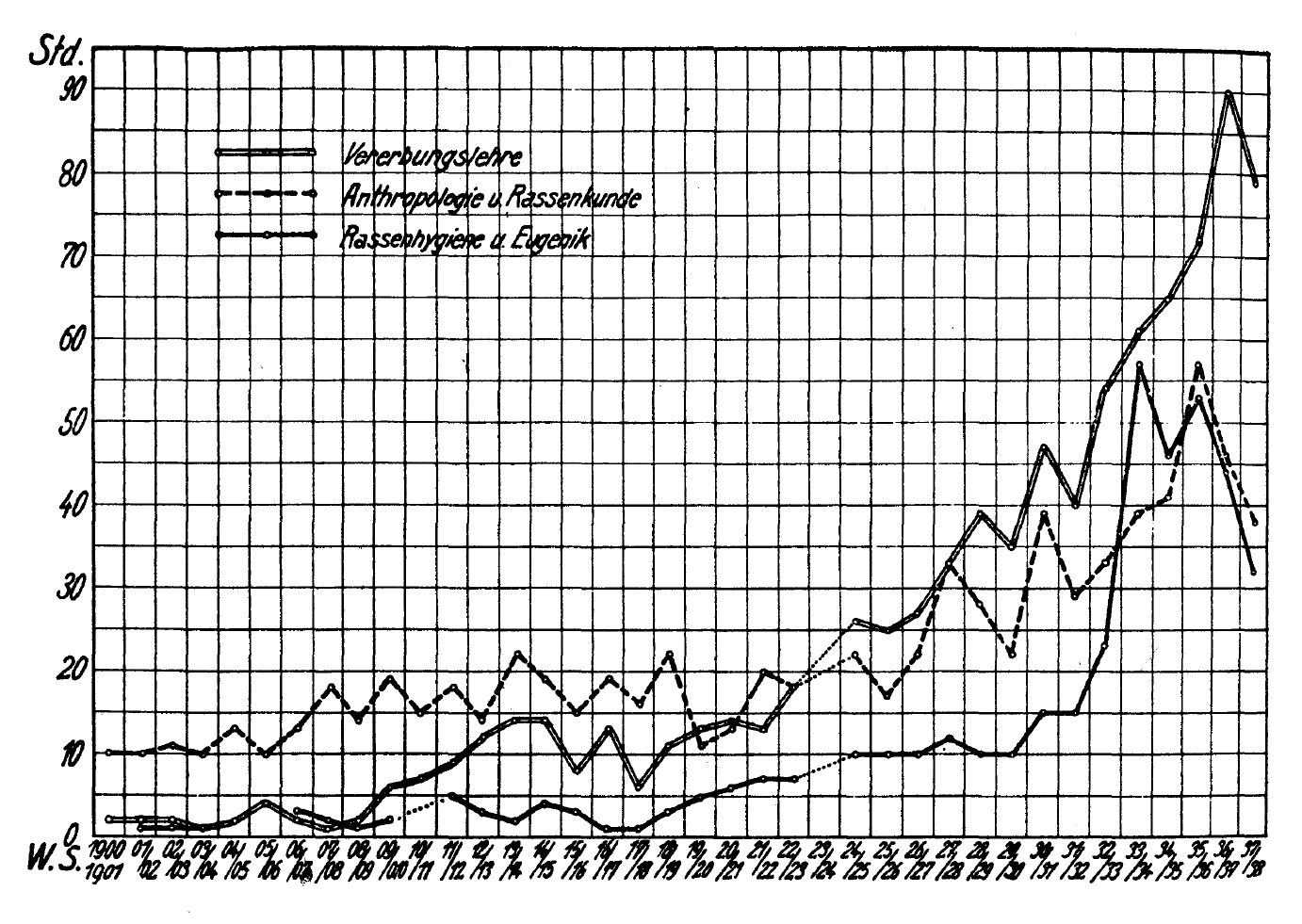
Figure 7. "Courses in
Genetics (double line), Anthropology (broken line),
and Racial Hygiene and Eugenics (solid line) Taught at German
Universities
since 1900." From Der Biologe, 9 (1938): 308. - Proctor (1988:39.)
◎1933年までに創刊された人種衛生学あるいは隣 接科学のリスト---Proctor (1988:39)
◎1923-1944年のドイツの大学で人種衛生学 とその関連分野の教授職リスト(Proctor 1988:80)--「人類学」および「精神医学」のタイトルでの研究教育タイトルを除く
| University | Chair | Professor |
| Berlin | Rassenhygiene | Fritz Lenz (1933-1945) |
| |
Anthropologie und Rassenbiologie | Wolfgang Abel (1943-1945) |
| Bonn | Rassenhygiene | Friedrich Panse (1937-1945) |
| Cologne | Erbbiologie und Rassenhygiene | Ferdinand Claussen (1939-1945) |
| Danzig | Erbbiologie und Rassenhygiene | Erich Grossmann (1942-1945) |
| Frankfurt | Erbbiologie und Rassenhygiene | Otmar von Verschuer (1935-1942) |
| Heinrich W. Kranz (1942-1945) | ||
| Giessen | Erb- und Rassenforschung | Heinrich W. Kranz (1937-1942) |
| Hermann Boehm (1942-1945) | ||
| Hamburg | Rassenhygiene | Wilhelm Weitz (1936-1945) |
| Heidelberg | Rassenhygiene | Ernst Rodenwaldt (1935-1945) |
| Jena | Menschliche Erblehre und Rassenpolitik | Karl Astel (1934-1945) |
| Sozialanthropologie | Hans F. K. Günther (1932-) | |
| Rasse und Recht | Falk Ruttke (1941-1945) | |
| Konigsberg | Rassenbiologie | Lothar Loeffler (1935-1942) |
| Leipzig | Rassen- und Volkerkunde | Otto Reche (1927-1945) |
| Munich | Rassenhygiene | Fritz Lenz (1923-1933) |
| Rassenbiologie und Rassenhygiene | Lothar Tirala (1933-1936) | |
| Rassenhygiene (honorary) | Alfred Ploetz (1936-1940) | |
| Prague | Rassenbiologie, Rassenkunde | Bruno K. Schultz (1942-1945) |
| Sozialanthropologie | Karl V. Muller (1942-1945) | |
| Rostock | Erbbiologie und Rassenhygiene | Hans Grebe (1944-1945) |
| Erb- und Rassenpflege (honorary) | Hermann Boehm (1937-1943) | |
| Strassburg | Erbbiologie und Rassenhygiene | Wolfgang Lehmann (1943-1945) |
| Tubingen | Rassenkunde | Wilhelm Gieseler (1938-1945) |
| Vienna | Rassen- und Volkerkunde | Otto Reche (1924-1927) |
| Rassenbiologie und Rassenhygiene |
Lothar Loeffler (1942-1945) |
|
| Wurzburg | Vererbungslehre und Rassenforschung | Ludwig Schmidt-Kehl (1937-1941) |
| Gunther,Just (1942-1945) |
Note: Most of these positions were established in medical faculties; some, however, were established in philosophical or legal faculties. Racial hygiene was often taught under the rubric of "anthropology" or "psychiatry"; I have not included these professorships here (for example, Eugen Fischer's chair for anthropology at Berlin, or Ernst Rüdin's chair at Munich). The people listed here represent only a few of the individuals who taught racial hygiene in German universities; most courses were offered not by full professors but by Dozenten. In 1941 Der Biologe (10[1941]:196) reported that thirty-two Dozenten für Biologie und Rassenkunde were active at twenty-three German colleges and universities and that the majority of these were young scholars between the ages of thirty and forty.
注:これらの職の多くは医学部に設置されたが、哲学
や法学部に設置されたものもある。人種衛生学はしばしば「人類学」や「精神医学」の名で教えられたが、ここではこれらの教授職は含めていない(たとえば、
ベルリンのオイゲン・フィッシャーの人類学講座や、ミュンヘンのエルンスト・リューディンの講座など)。ここに挙げた人物は、ドイツの大学で人種衛生学を
教えた人物のほんの一部に過ぎず、ほとんどの講座は正教授ではなく、ドゼンテンによって開講されていた。1941年のDer Biologe
(10[1941]:196) は、ドイツの23の大学で32人のDozenten für Biologie und
Rassenkundeが活動しており、その大半は30歳から40歳の若い研究者であったと報告している。
◎ベルリン人種衛生学会の「結婚前の健康診断書の法 的な交換と人種衛生的な結婚の禁止について」(1917)
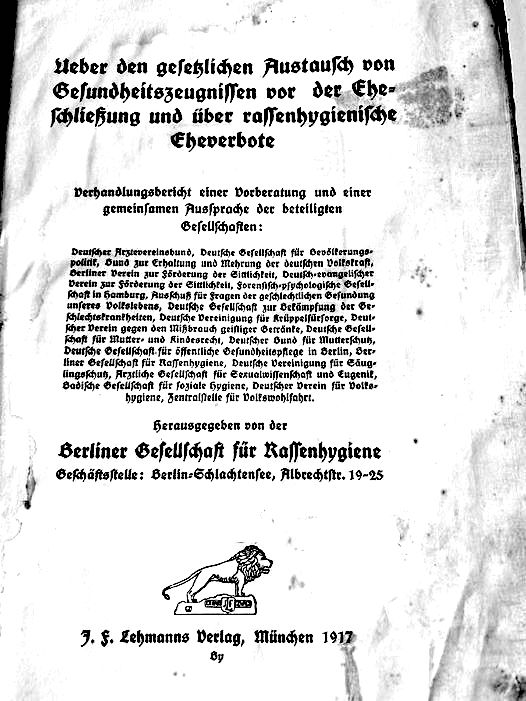
◎はじめは福祉や社会衛生学として、次に、断種や
「不能者や不適応者」への安楽死として、そして最後は、ユダヤ人やロマ・シンティなどの民族浄化へ
◎Proctor, Robert. Racial hygiene : medicine under the Nazis. Harvard University Press, 1988.
ナチス政権下の科学史を研究する学者たちは、一般 に、ナチスによる科学の破壊や知的・自由主義的価値の堕落に集中している。Proctor, Robert. Racial hygiene : medicine under the Nazis. Harvard University Press, 1988年は、科学者自身がナチスの人種政策の構築にどのように参加したかに焦点を当てたものである。つまり、ナチスの政治的イニシアチブの多くが科 学界から生まれ、医学者が国家社会主義政策の重要な要素を積極的に設計し、運営していたということである。本書は、不妊手術や去勢手術、ユダヤ人と非ユダ ヤ人の結婚を禁止する法律、そして「生きる価値のない命」を破壊する大規模な計画へのドイツの医学界の関与について、これまでで最も包括的な説明を試みて いる。この研究は、医師たちが「ユダヤ人問題」を「医学的問題」として考えようとし たこと、医学雑誌がドイツのユダヤ人とジプシーの「問題」に対する「最終解決策」を見つける必要性について公然と議論したことを 追跡している。プロクターは、このような考え方がドイツに限ったことではないことを私たちに気づかせてくれる。19世紀後半、アメリカやヨーロッパで起 こった社会ダーウィニズムは、人種衛生学の理論を生み出し、より優れた、より健康な、より強い人種を育成するために、さまざまな国籍の愛好家たちによって 受け入れられました。また、ナチス政権下で盛んになった「オーガニック」健康運動についても、喫煙や飲酒を減らす運動、パン屋に全粒粉パンの製造を義務付 ける運動などが紹介されている。また、別章では、社会主義医師協会における医師の抵 抗運動の出現を 紹介している。本書は、ドイツ国家文書やこの時期に発行された200以上の医学雑誌など、当時の資料の綿密な分析に基づいている。プロクターは、単に物語 を語るだけではなく、「科学の政治哲学」とでも呼ぶべきもの、すなわち、国家の政策を形成する運動が、科学の構造や優先順位をも形成しうるということにつ いて、考察を促すことを意図しているのである。本書は、歴史家、医師、科学史・科学哲学関係者だけでなく、科学政策や医療倫理に関心を持つ人々にとって も、幅広い示唆を与えてくれるものである」https://ci.nii.ac.jp/ncid/BA06532436.。
+
◎北方人種理論(=北欧人種優位説)Nordic theory (Nordic race)
北方人種理論の嚆矢は、ジョゼフ・ドゥニケール (Joseph Deniker)に遡れる。ジョゼフ・ドゥニケール(Joseph Deniker 1952-1918)はロシア生まれのフランスの博物学者、人類学者.ロシア南部のアストラハンにフランス人の両親のもとに生まれた。サンクトペテルブル クの大学、工科研究所で学び、エンジニアとなった。コーカサスの石油地域や中部ヨーロッパ、イタリア、ダルマチアを旅した。フランスに移住して、ソルボン ヌ大学で学び、1886年に自然科学の学位を得て、1888年にパリ自然史博物館の司書主任に就任した。『世界地理事典』(Dictionnaire de geographie universelle)の執筆者の一人で、人類学や動物学の学術雑誌に多くの論文を寄稿した。1904年にイギリスの王立人類学研究所に招かれ、ハクス リー記念講師職を受けた。人類学のドゥニケールの主著は『地球の人種と民族』("Les races et les peuples de la terre")である。ドゥニケールの作成したヨーロッパの人種地図は20以上に上る人種に分類したもので、当時多くの研究に引用された。ヨーロッパにお ける主要な人種が何種類あるかについて、ウィリアム・Z・リプレー(William Z. Ripley)らと論争した。ドゥニケールの人種の分類では、ヨーロッパの主要な人種を「北方人種(Nordic race)」「地中海人 種」「東洋人種(Oriental)」、「ディナール人種」、「イベリア人種(Ibero-Insular)」、「アルプス人種」(Nordic、 Littoral、Oriental、Adriatic 、Ibero-Insular、Occidental)」に分けることを提案した。さらにサブタイプとして、Sub-Nordic、North- Occidental、Vistulian、Sub-Adriaticを提案した。北方人種には、ゲルマン人種、スラブ人種、バルト人種、および主にバル ト・フィン諸語を話者とするフィン・ウゴル人種が含まれる。

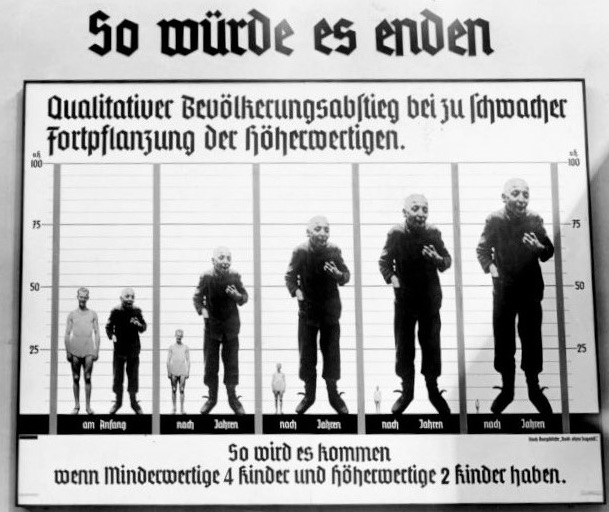
Deniker's "Races de l'Europe" from 1899, listing as "principal races": Nordic, Littoral, Oriental, Dinaric, Iberic, Occidental and as "secondary races": Subnordic, Nord-Occidental, Vistulian, Subadriatic. Towards the north and east, boundaries to the territory settled by non-European races are shown: the Sami (Lap) (north), Eastern Finns (east) and Turco-Mongols (east and south-east)/ Eugenics poster at the exhibition Wonders of Life in Berlin in 1935 showing demographic projections under the assumption of higher fertility of the "inferior" (Minderwertige) relative to the "superior" (Höherwertige).
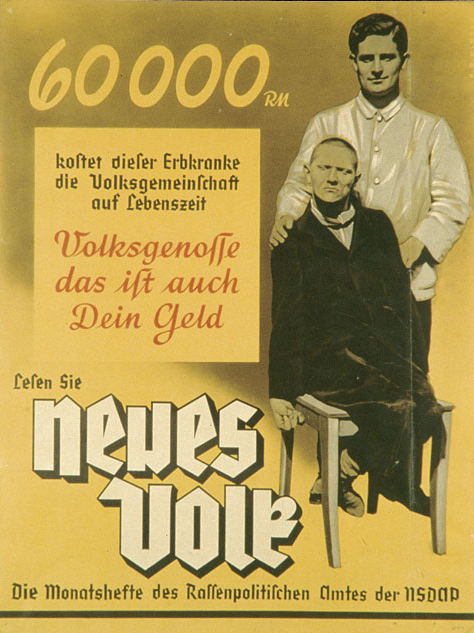
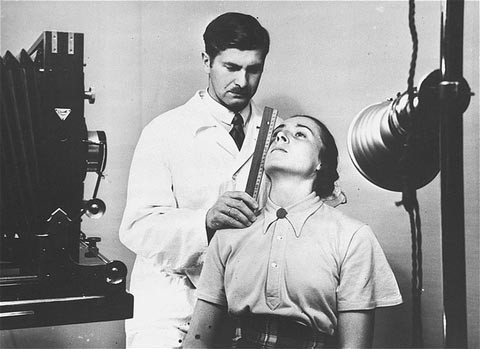
(左)Propaganda for Nazi Germany's T-4 Euthanasia Program: "This person suffering from hereditary defects costs the community 60,000 Reichsmark during his lifetime. Fellow German, that is your money, too." from the Office of Racial Policy's Neues Volk.(→「T-4計 画:ナチが 実施した安楽殺(=「慈悲殺」)」)(→「ナチ スの人種差別主義」 ホロコースト百科事典)/(右)Kaiser Wilhelm Institute for Anthropology, Human Genetics, and Eugenics(ヴィルヘルム皇帝人類学、人類遺伝学、および優生学大学)で、女性の身体的特徴を測定して人種の判断を試みる人種衛生士。ドイツ、ベル リン、日付不詳。
●人種衛生学(概念) の確立としての "Grundriß der menschlichen Erblichkeitslehre und Rassenhygiene(人間遺伝学と人種衛生学概論), 1923"
人種衛生学(概念)の確立としての "Grundriß der menschlichen Erblichkeitslehre und Rassenhygiene(人間遺伝学と人種衛生学概論), 1923"がある。これは2巻本で、第1巻は、エルヴィン・バウアーとオイゲン・フィッシャーとフリッツ・レンツの3人の分担執筆による『人類の遺伝 (Menschliche Erblichkeitslehre)』であり、第2巻はフリッツ・レンツの単著の『人類の淘汰と人種衛生 (Menschliche Auslese und Rassenhygiene)』からなりたつ。

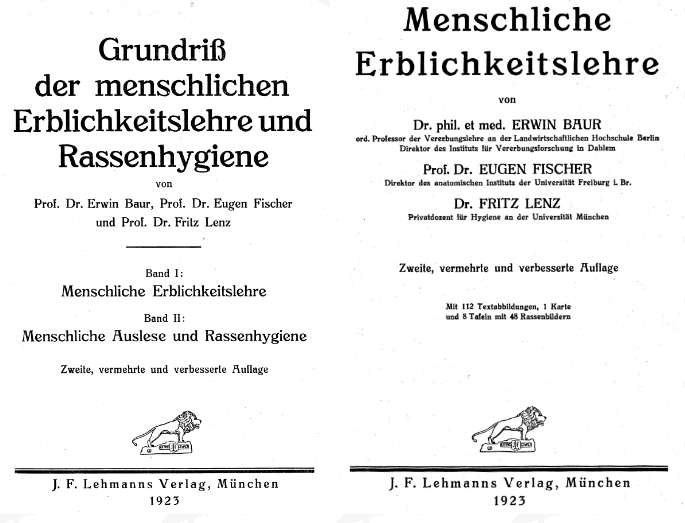
この本は1823年11月8-9日のミュンヘン一揆 (Munich Putsch)[クーデター未遂事件]でランズバーグ刑務所に収監されている時に読んで、その内容が後の『我が闘争』に反映されたという。とりわけ、後者 の書物の「国民と人種」「国家」の章に反映されている。
| Establishing the
race-hygienic state In January 1919, railway locksmith Anton Drexler found ed the German Workers Party (DAP), renamed National Socialist German Workers Party (NSDAP) in 1920. Its 55th member, Adolf Hitler, became Parteifuhrer on 29 July 192172 and established the SA (Sturmabteilung, August 1921) and SS (Schutzstaffel, January 1923). In Landsberg prison, over 8 months after his failed Muni ch Putsch (November 1923), Hitler read Principles of Human Heredity and Race Hygiene by Bauer, Fischer and Lenz, and wrote M ein Kampf Chapters from the lat er on "Nation and Race" and "Th e State" linked positive and negative racial eugenics with folkish state, placing race and health at life's center: the healthy child as national treasure; not begetting honorable if infirm, but shameful if healthy. Opposite nature, Hitler utterly dismissed ethical conceptions as "only pur e expressions of feeling" compared to "exact scientific truth" and "cold logic." Reviewing Mein Kampf, Fritz Lenz approvingly called National Socialism "applied biology:" "Hitler is the first politician of really great influence, who has recognized racial hygiene as a central task of all politics and wants to engage hims elf forcefully in action for this. " While depictions of Jews were "one-sided and exaggerated," Lenz affirmed much of the program. In August 1929, Gerhard Wagner found ed the National Socialist German Physicians League. It is estimated that one in six German s physicians were Jewish, and only 6 percent of physicians supported the NSDAP; how ever, that numb er grew to 27 percent months after Hitler's appointment as chancellor in January 1933. By the summer of that year, the Nazis began implementing eugenic legislation. On 14 July 1933, non-Nazi parties were banned and the Law for the Prevention of Congenitally Ill Offspring was passed for "purifying the Volkskorper and gradually eradicating diseased heredity," a significant step toward a biology-driven society. A 1935 amendment included eugenic abortion. Th e Law against Dangerous and Habitual Criminals (November 1933) extended sterilization. Ultimately, ca 400,000 people were sterilized (1934 45), including 40,000 in occupation, eight times US totals (1907-45) and 30 times high er by rate. After the September 1935 Law for the Protection of German Blood and German Honor, Himmler established Lebensborn e. V. (Fount of Life) for non-marital progeny, particularly of the SS. |
人種衛生国家の確立 1919年1月、鉄道錠前工のアントン・ドレクスラーはドイツ労働者党(DAP)を設立し、1920年に国家社会主義ドイツ労働者党(NSDAP)と改名 した。その55番目のメンバーであるアドルフ・ヒトラーは、1921年7月29日に党首に就任し、SA(Sturmabteilung、1921年8月) とSS(Schutzstaffel、1923年1月)を設立した。ランツバーグ刑務所では、ミュンヘン一揆(1923年11月)の失敗から8ヶ月以上が 経過し、ヒトラーはバウアー、フィッシャー、レンツの「人間遺伝学と人種衛生学原理」を読み、(後の、我が闘争の)「国民と人種」と「国家」の章を書き、 人種と健康を人生の中心に据え、肯定的にも否定的にも人種優生学と民族国家を結び付けている。 ヒトラーは、「正確な科学的真理」や「冷たい論理」に比べて、倫理的観念を「純粋な感情の表現にすぎない」として、まったく否定している。『我が闘争』を 評して、フリッツ・レンツ は、国民=人種社会主義(ナチズム)を「応用生物学」と呼び、次のように賞賛している。「ヒトラーは、人種的衛生をすべての政治の中心的課題として認識 し、そのための行動に力強く関与しようとする、本当に大きな影響力を持つ最初の政治家である」。ユダヤ人に関する描写は「一方的で誇張されている」としな がらも、レンツはこのプログラムの多くを肯定している。 1929年8月、ゲルハルト・ワグナーは、国家社会主義ドイツ医師連盟を設立した。ドイツの医師の6人に1人はユダヤ人と推定され、 NSDAPを支持する医師はわずか6%だったが、1933年1月にヒトラーが首相に任命されると、その数は27%にまで増加した。その年の夏には、ナチス は優生学的な法律を実施し始めた。1933年7月14日、ナチス以外の政党は禁止され、「国民を浄化し、病気の遺伝を徐々に根絶する」ための「遺伝病子孫 防止法」が成立し、生物学主導の社会への重要な一歩を踏み出すことになった。 1935年の改正では、優生学的な中絶が盛り込まれた。1933年11月の「危険犯及び常習犯に対する法律」では、不妊手術が拡大された。最終的に、約 40万人が不妊手術を受け(1934年45月)、うち4万人が職業に就いていた。これは、アメリカの総計(1907-45)の8倍、率にして30倍の数字 である。1935年9月の「ドイツの血と名誉の保護に関する法律」の後、ヒムラーは特にSSの非婚の子孫のためにLebensborn e. V. (Fount of Life)を設立した。 |
| Kirk C. Allison,
"EUGENICS, RACE HYGIENE, ANDTHE HOLOCAUST: Antecedents and
consolidations" (Pp.45-58.) Jonathan C. Friedman ed., 2012. The Routledge History of the Holocaust. p.49. London: Routledge. |
++
| Nazi eugenics
refers
to the social policies of eugenics in Nazi Germany. The racial ideology
of Nazism placed the biological improvement of the German people by
selective breeding of "Nordic" or "Aryan" traits at its center.[1]
Eugenics research in Germany before and during the Nazi period was
similar to that in the United States (particularly California), by
which it had been heavily inspired. However, its prominence rose
sharply under Adolf Hitler's leadership when wealthy Nazi supporters
started heavily investing in it. The programs were subsequently shaped
to complement Nazi racial policies.[2]
Those targeted for destruction under Nazi eugenics policies were
largely people living in private and state-operated institutions,
identified as "life unworthy of life" (Lebensunwertes Leben). They
included prisoners, degenerates, dissidents, and people with congenital
cognitive and physical disabilities (erbkranken)- people who were
considered to be feeble-minded. In fact being diagnosed with
"feeblemindedness" (in German, Schwachsinn) was the main label approved
in forced sterilization,[3] which included people who were diagnosed by
a doctor as, or otherwise seemed to be: Epileptic Schizophrenic[4] Manic-depressive (now known as bipolar) Cerebral palsy or muscular dystrophy Deaf and/or blind Homosexual or "transvestites" (which at the time was used to refer to intersex and transgender people, particularly trans women[5][6]) Anyone else considered to be idle, insane, and/or weak as per "feeblemindedness" All of these were targeted for elimination from the chain of heredity. More than 400,000 people were sterilized against their will, while up to 300,000 were killed under the Aktion T4 euthanasia program.[7][8][9][10] Thousands more also died from complications of the forced surgeries, the majority being women from forced tubal ligations.[3] In June 1935, Hitler and his cabinet made a list of seven new decrees, in which number 5 was to speed up the investigations of sterilization.[11] "An attempt to relieve the
overcrowding of psychiatric hospitals, in fact, played a significant
role in Germany's decision to institute compulsory sterilization and,
later, the killing of psychiatric patients. [...] Hitler's letter
authorizing the program to kill mental patients was dated September 1,
1939, the day German forces invaded Poland. Although the program never
officially became law, Hitler guaranteed legal immunity for everyone
who took part in it.[4]
"
In German, the concept of "eugenics" was mostly known under the term of Rassenhygiene or "racial hygiene". The loanword Eugenik was in occasional use, as was its closer loan-translation of Erbpflege. An alternative term was Volksaufartung (approximately "racial improvement").[12] |
ナチス優生学とは、ナチス・ドイツにおける優生学の社会政策である。ナ
チズムの人種思想は、「北欧人」または「アーリア人」の形質の選択的交配によるドイツ国民の生物学的改良をその中心に据えていた[1]。ナチス時代以前お
よび当時のドイツにおける優生学研究は、大きな影響を受けたアメリカ(特にカリフォルニア)におけるそれと同様であった。しかし、アドルフ・ヒトラーの指
導のもと、ナチスを支持する富裕層が多額の資金を投じるようになり、その存在感は急激に増した。ナチスの優生学政策のもとで破壊の対象とされたのは、主に
民間や国が運営する施設で暮らす人々で、「生きるに値しない命」(Lebensunwertes
Leben)として認識された人々であった[2]。囚人、堕落者、反体制者、先天性の認知障害や身体障害(erbkranken)、つまり頭の弱いとされ
る人たちが含まれていたのです。実際、「気が弱い」(ドイツ語ではSchwachsinn)と診断されることが強制不妊手術で認められた主なレッテルであ
り、医師によってそう診断された人、あるいはそう思われた人が含まれていた[3]。 てんかん 統合失調症[4](Schizophrenic 躁鬱病(現在では双極性障害として知られている) 脳性まひまたは筋ジストロフィー 耳が聞こえない、または目が見えない 同性愛者または「女装者」(当時はインターセックスやトランスジェンダー、特にトランス女性を指す言葉として使われていた[5][6])。 その他、怠惰者(放浪者)、精神異常者、弱者(feblemindedness)とみなされる者。 これらはすべて、遺伝の連鎖から排除される対象となった。また、数千人が強制手術の合併症で死亡し、その大部分は強制的な卵管結紮術を受けた女性であった [7][8][9][10]。 [1935年6月、ヒトラーとその内閣は7つの新しい政令のリストを作成し、その中の5番目は不妊手術の調査を加速させるというものだった[11]。 「精神病院の過密状態を緩和する試みは、実際、ドイツが強制不妊手術と、
後に精神科患者の殺害を制定する決定に大きな役割を果たすことになった。[中略]
精神科患者の殺害計画を許可するヒトラーの手紙は、ドイツ軍がポーランドに侵攻した1939年9月1日付のものである。このプログラムは公式には法律化さ
れなかったが、ヒトラーはプログラムに参加したすべての人に法的免責を保証した[4]」。
ドイツ語では、「優生学」の概念は主にRassenhygiene, Racial hygieneまたは「人種衛生」の用語で知られていた。Eugenikという外来語は、 Erbpflegeという外来語と同様に時折使用されていた。別の用語はVolksaufartung(およそ「人種的改善」)であった[12]。 |
| The early German eugenics
movement was led by Wilhelm
Schallmayer and Alfred Ploetz.[13][14]
Henry Friedlander wrote that although the German and American eugenics
movements were similar, the German movement was more centralized and
did not contain as many diverse ideas as the American movement.[14]
Unlike the American movement, one publication and one society, the
German Society for Racial Hygiene, represented all eugenicists.[14] Edwin Black wrote that after the eugenics movement was well established in the United States, it was spread to Germany. California eugenicists began producing literature promoting eugenics and sterilization and sending it overseas to German scientists and medical professionals.[15] By 1933, California had subjected more people to forceful sterilization than all other U.S. states combined. The forced sterilization program engineered by the Nazis was partly inspired by California's.[2] In 1927, the Kaiser Wilhelm Institute for Anthropology (KWIA), an organization which concentrated on physical and social anthropology as well as human genetics, was founded in Berlin with significant financial support from the American philanthropic group, the Rockefeller Foundation.[16] German professor of medicine, anthropology and eugenics Eugen Fischer was the director of this organization, a man whose work helped provide the scientific basis for the Nazis' eugenics policies.[17][18] The Rockefeller Foundation even funded some of the research conducted by Josef Mengele before he went to Auschwitz.[15] Upon returning from Germany in 1934, where more than 5,000 people per month were being forcibly sterilized, the California eugenics leader C. M. Goethe bragged to a colleague: You will be interested to know
that your work has played a powerful part in shaping the opinions of
the group of intellectuals who are behind Hitler in this epoch-making
program. Everywhere I sensed that their opinions have been tremendously
stimulated by American thought... I want you, my dear friend, to carry
this thought with you for the rest of your life, that you have really
jolted into action a great government of 60 million people.[15]
Eugenics researcher Harry H. Laughlin often bragged that his Model Eugenic Sterilization laws had been implemented in the 1935 Nuremberg racial hygiene laws.[19] In 1936, Laughlin was invited to an award ceremony at Heidelberg University in Germany (scheduled on the anniversary of Hitler's 1934 purge of Jews from the Heidelberg faculty), to receive an honorary doctorate for his work on the "science of racial cleansing". Due to financial limitations, Laughlin was unable to attend the ceremony and had to pick it up from the Rockefeller Institute. Afterwards, he proudly shared the award with his colleagues, remarking that he felt that it symbolized the "common understanding of German and American scientists of the nature of eugenics."[20] |
初期のドイツの優生学運動はヴィルヘルム・シャルマイヤーとアルフレッ
ド・プレッツ(Rassenhygiene, Racial
hygieneの命名者)に率いられていた[13][14]。ヘンリー・フリードラ
ンダーは、ドイツとアメリカの優生学運動は似ているが、ドイツの運動は
アメリカの運
動ほど多様な考えを含まず、より集中的だったと書いている[14]。
アメリカの運動とは異なり、一つの出版物と一つの学会、ドイツ人種衛生学会がすべての優生学者が代表されていた[14]。 エドウィン・ブラックは、優生学運動がアメリカで十分に確立された後、それがドイツに広まったと書いている。カリフォルニアの優生学者が優生学と不妊手術 を促進する文献を作成し、ドイツの科学者や医療専門家に海外に送り始めた[15]。 1933年までに、カリフォルニアは他のすべてのアメリカの州の合計よりも多くの人々を強制的不妊手術の対象としたのである。ナチスによって計画された強 制不妊手術プログラムは、カリフォルニア州のものに一部影響を受けていた[2]。 1927年、カイザー・ヴィルヘルム人類学・人類遺 伝学・優生学研究所(KWI-A)が、アメリカの慈善団体であるロックフェラー財団からの多額の資金援助を受けてベルリンに設立 され、身体人類学、社会人類学、人類遺伝学に集中する組織となった[16]。 [ロックフェラー財団は、ヨーゼフ・メンゲレがアウシュビッツに行く前に行った研究の一部にも資金を提供 している[15]。 1934年、毎月5,000人以上が強制的に不妊手術を受けていたドイツから帰国したカリフォルニアの優生学指導者C・M・ゲーテは、同僚にこう自慢して いる。 「あなたの仕事が、この画期的な計画でヒトラーの後ろ盾となっている知識
人たちの意見を形成する上で、強力な役割を果たしたことを知ったら、きっと興味を持たれるでしょう」。彼らの意見は、アメリカの思想から多大な刺激を受け
ていることを、私はいたるところで感じた......。親愛なる友人であるあなたには、この思いを生涯持ち続けて欲しい。あなたは、6,000万人の国民
を抱える大政府を本当に揺り動かしたのだ、と」。
優生学研究者のハリー・H・ローリンはしばしば、彼のモデル優生学的不妊手術法が1935年のニュルンベルクの人種衛生法に実装されたと自慢していた [19]。 1936年にローリンはドイツのハイデルベルク大学での表彰式(ヒトラーによるハイデルベルクの教員からのユダヤ人の粛清の記念日に予定)に招待されて、 「人種浄化の科学」に関する研究に対して名誉博士号を授与されている。経済的な理由で授賞式に出席できなかったローリンは、ロックフェラー研究所に(証書 を)受け取りに行かなければならなかった。その後、彼は誇らしげに同僚たちと賞を分かち合い、「優生学の本質に関するドイツとアメリカの科学者の共通の理 解」を象徴しているように感じると発言している[20]。 |
| Adolf Hitler read about racial
hygiene during his imprisonment in Landsberg Prison.[21] Hitler
believed the nation had become weak, corrupted by dysgenics, the
infusion of degenerate elements into its bloodstream.[22] The racialism
and idea of competition, termed social Darwinism in 1944, were
discussed by European scientists and also in the Vienna press during
the 1920s. Where Hitler picked up the ideas is uncertain. The theory of
evolution had been generally accepted in Germany at the time, but this
sort of extremism was rare.[23] In his Second Book, which was
unpublished during the Nazi era, Hitler praised Sparta, (using ideas
perhaps borrowed from Ernst Haeckel),[24] adding that he considered
Sparta to be the first "Völkisch State". He endorsed what he perceived
to be an early eugenics treatment of deformed children: Sparta must be regarded as the
first Völkisch State. The exposure of the sick, weak, deformed
children, in short, their destruction, was more decent and in truth a
thousand times more humane than the wretched insanity of our day which
preserves the most pathological subject, and indeed at any price, and
yet takes the life of a hundred thousand healthy children in
consequence of birth control or through abortions, in order
subsequently to breed a race of degenerates burdened with
illnesses.[25][26]
|
アドルフ・ヒトラーはランツベルク刑務所に収監されている間に人種衛生
について読んでいた[21]。ヒトラーは国家が弱体化し、逆淘汰(dysgenics)によって堕落したと考えており、血液中に退化した要素を注入してい
た(と考えた)
[22]。人種主義や競争の考え方は、1944年に社会ダーウィニズムと呼ばれ、1920年代にヨーロッパの科学者やウィーンの新聞で議論されていた。ヒ
トラーがどこでその考えを手に入れたのかは不明である。進化論は当時のドイツでは一般的に受け入れられていたが、このような過激思考は珍しかった
[23]。
ナチス時代に未発表だった『第二の書(続・我が闘争)』において、ヒトラーは(おそらくエルンスト・ヘッケルから借りた考えで)スパルタを賞賛し、スパル
タを最初の「フェルキッシュ国家」だと考えていると付け加えている[24]。彼は奇形児に対する初期の優生学的治療と思われるものを支持した。 「スパルタは最初のフェルキッシュ国家と見なされなければならない。病弱
で奇形児の暴露、要するに彼らの破壊は、最も病的な対象を保存し、実際どんな代償を払っても、その後病気を背負った退化した人種を繁殖させるために、出生
コントロールの結果として、あるいは中絶によって10万の健康な子供の命を奪う現代の哀れな狂気よりも、よりまともで、実際のところ千倍はより人間的
だった[25][26]」
|
| In organizing their eugenics
program the Nazis were inspired by the United States' programs of
forced sterilization, especially on the eugenics laws that had been
enacted in California.[15] The Law for the Prevention of Hereditarily
Diseased Offspring, enacted on July 14, 1933, allowed the compulsory
sterilisation of any citizen who according to the opinion of a "Genetic
Health Court" "suffered" from a list of alleged genetic disorders and
required physicians to register every case of hereditary illness known
to them, except in women over 45 years of age.[27] Physicians could be
fined for failing to comply. In 1934, the first year of the Law's
operation, nearly 4,000 people appealed against the decisions of
sterilization authorities. A total of 3,559 of the appeals failed. By
the end of the Nazi regime, over 200 Hereditary Health Courts
(Erbgesundheitsgerichte) were created, and under their rulings over
400,000 persons were sterilized against their will.[28] |
ナチスは優生学プログラムを組織するにあたり、アメリカの強制不妊手術
プログラム、特にカリフォルニア州で制定された優生学法に影響を受けていた。
[1933年7月14日に制定された「遺伝性疾患子孫の予防に関する法律」は「遺伝性健康裁判所」の意見によれば、申し立てられた遺伝性疾患のリストに
「苦しんでいる」市民は誰でも強制不妊手術を受けることができ、医師は45歳以上の女性を除いて、医師が知るすべての遺伝性疾患の例を登録しなければなら
なかった[27]
。この法律が施行された最初の年である1934年には、4,000人近くが不妊手術の決定に対して不服を申し立てた。そのうち3,559人が不服申し立て
を行ったが、失敗に終わった。ナチス政権の終わりには、200以上の遺伝的健康裁判所(Erbgesundheitsgerichte)が設立され、その
判決により40万人以上の人々が本人の意思に反して不妊手術を受けた[28]。 |
| The Hadamar Clinic was a mental
hospital in the German town of Hadamar used by the Nazi-controlled
German government as the site of Action T4. The Kaiser
Wilhelm Institute of Anthropology, Human Heredity, and Eugenics
was founded in 1927. Hartheim Euthanasia Centre was also part of the
euthanasia programme where the Nazis killed individuals they deemed
disabled. The first method used involved transporting patients by buses
in which the engine exhaust gases were passed into the interior of the
buses, and so killed the passengers. Gas chambers were developed later
and used pure carbon monoxide gas to kill the patients.[citation
needed] In its early years, and during the Nazi era, the Clinic was
strongly associated with theories of eugenics and racial hygiene
advocated by its leading theorists Fritz Lenz and Eugen Fischer, and by
its director Otmar von Verschuer. Under Fischer, the sterilization of
so-called Rhineland Bastards was undertaken. Grafeneck Castle was one
of Nazi Germany's killing centers, and today it is a memorial place
dedicated to the victims of the Action T4.[29] |
ハダマール診療所は、ナチス支配下のドイツ政府が「行動T4」の現場と
して使用したドイツの町ハダマールの精神病院である。カ
イザー・ヴィルヘルム人類学・人類遺伝学・優生学研究所(KWI-A)は、1927年に設立されました。ハルトハ
イム安楽死センターもまた、ナチスが障害者とみなした人物を殺害する安楽死プログラムの一環でした。最初の方法は、バスで患者を輸送し、エンジンの排気ガ
スをバスの内部に通して、乗客を殺すというものだった。その後、ガス室が開発され、純粋な一酸化炭素ガスを使用して患者を殺した[引証が必要]。
初期からナチス時代にかけて、クリニックはその主要な理論家フリッツ・レンツとオイゲン・フィッシャー、および院長オトマー・フォン・ヴェルシュアーが提
唱した優生学や人種衛生の理論と強く結びついていた。フィッシャーのもとでは、いわゆるラインラント・バスタードの不妊手術が行われた。グラーフェネック
城はナチス・ドイツの殺戮拠点の一つであり、現在はT4アクションの
犠牲者に捧げられた記念碑的な場所となっている[29]。 |
| The Law for Simplification of
the Health System of July 1934 created Information Centers for Genetic
and Racial Hygiene, as well as Health Offices. The law also described
procedures for 'denunciation' and 'evaluation' of persons, who were
then sent to a Genetic Health Court where sterilization was
decided.[30]
Information to determine who was considered 'genetically sick' was
gathered from routine information supplied by people to doctor's
offices and welfare departments. Standardized questionnaires had been
designed by Nazi officials with the help of Dehomag (a subsidiary of
IBM in the 1930s), so that the information could be encoded easily onto
Hollerith punch cards for fast sorting and counting.[31]
In Hamburg, doctors gave information into a Central Health Passport
Archive (circa 1934), under something called the 'Health-Related Total
Observation of Life'. This file was to contain reports from doctors,
but also courts, insurance companies, sports clubs, the Hitler Youth,
the military, the labor service, colleges, etc. Any institution that
gave information would get information back in return. In 1940, the
Reich Interior Ministry tried to impose a Hamburg-style system on the
whole Reich.[32] |
1934年7月の「保健制度の簡素化に関する法律」では、保健所と同様
に、遺伝的・人種的衛生に関する情報センターが設立された。この法律には、不妊手術が決定される遺伝子保健法廷に送られる人物の「告発」と「評価」の手順
も記されていた[30]。誰が「遺伝子疾患」とみなされるかを決定する情報は、人々が医院や福祉部門に提供する日常的な情報から集められる。標準化された
質問表が、デホマッグ(1930年代のIBMの子会社)の助けを借りてナチ当局によって設計されており、その情報は高速ソートとカウントのためにホレリ
ス・パンチカードに簡単にエンコードすることができた。 [31]
ハンブルクでは、医師は「健康関連総合生活観察」と呼ばれるものの下で中央健康パスポートアーカイブ(1934頃)に情報を提供する。このファイルには、
医師だけでなく、裁判所、保険会社、スポーツクラブ、ヒトラーユーゲント、軍、労働局、大学などからの報告も含まれることになっていた。情報を提供した機
関には、その見返りとして情報が返ってきた。1940年、帝国内務省はハンブルク式のシステムを帝国全体になかば強制的に導入しようとした[32]。 |
| After the Nazis passed the
Nuremberg Laws in 1935, it became compulsory for both marriage partners
to be tested for hereditary diseases in order to preserve the perceived
racial purity of the Aryan race. Everyone was encouraged to carefully
evaluate his or her prospective marriage partner eugenically during
courtship. Members of the SS were cautioned to carefully interview
prospective marriage partners to make sure they had no family history
of hereditary disease or insanity, but to do this carefully so as not
to hurt the feelings of the prospective fiancée and, if it became
necessary to reject her for eugenic reasons, to do it tactfully and not
cause her any offense.[33] |
1935年にナチスがニュルンベルク法を成立させると、アーリア人種の
純粋性を保つために、結婚相手には遺伝性疾患の検査を受けることが義務づけられた。求婚の際には、誰もが結婚相手を優生学的に慎重に評価するよう奨励され
ました。SSのメンバーは、結婚相手候補に遺伝性疾患や精神異常の家系がないことを確認するために慎重に面接するように注意されたが、婚約者候補の感情を
傷つけないように慎重に行い、優生学的理由で女性を拒絶する必要が生じた場合には、機転を利かせて行い、婚約女性を不快にさせないようにすることが求めら
れていた[33]。 |
| The Nazi's policies on abortions
were conceived of alongside the general Nazi eugenics program. Upon
coming to power, the Nazis restricted advertisements on the sale of
contraceptives.[34] In May 1933, the Nazis reintroduced earlier laws
outlawing the advertisement of abortion procedures and abortifacients
to the public. In September of the same year, the Berlin Council of
Physicians warned its members that "proceedings will be taken against
every evil-doer who dares to injure our sacred healthy race."[34]
Abortion procedures were placed under strict political control.
Abortions for eugenic reasons were also prohibited during this period,
but in some hereditary health courts such abortions were exempt from
punishment. (This consideration extended to the exemption of punishment
for a Jewish couple who attempted to procure an abortion in 1938, on
the basis that the law did not protect Jewish embryos.)[34] |
ナチスの中絶に関する政策は、ナチスの一般的な優生学プログラムと並行
して考えられていた。1933年5月、ナチスは中絶手術と堕胎薬の広告を禁止する以前の法律を再導入した[34]。同年9月、ベルリン医師評議会は、「我
々の神聖な健康な人種を傷つけることを敢えてするすべての悪人に対して手続きが取られるだろう」と会員に警告した[34]。優生学的な理由による中絶もこ
の時期には禁止されていたが、いくつかの遺伝健康裁判所(hereditary health
courts)ではそのような中絶は処罰から免除されていた。(この配慮は、1938年に中絶を行おうとしたユダヤ人夫婦に対して、法律がユダヤ人の胚を
保護しないことを理由に刑罰を免除するまでに及んでいる)[34]。 |
| Doctors' trial; Elfriede Lohse-Wächtler; German
Blood Certificate; German
Society for Racial Hygiene(Deutsche Gesellschaft für Rassenhygiene); Lebensborn; Nazi
human experimentation; Nazi racial
theories; Nordic
race ; Nur für Deutsche; Physicians in the Nazi Party; Racial
policy of Nazi Germany; Racial purity; Rassenschande; Reich Citizenship
Law; Reinrassig; Sterilization of deaf people in Nazi Germany;
Volksdeutsche; Volksliste; |
ニュルンベルク医師裁判;Elfriede Lohse-Wächtler;ドイツ血液証明書;
ドイツ人種衛生協会1905-1945(German
Society for Racial Hygiene);Lebensborn(「レーベンスボルン」→ナチスの「生命の泉」計画と優生学);ナチの人体実験(Nazi
human experimentation);ナチズムと人種;北方理論(北
方人種);Nur für
Deutsche;ナチ党内の医師;ナチドイツの人種政策;人種の純潔;Rassenschande;Reich Citizenship
Law;Reinrassig;ナチのろう者に対する不妊化;Volksdeutsche;Volksliste; 名誉アーリア人; |
| https://en.wikipedia.org/wiki/Nazi_eugenics |
https://www.deepl.com/ja/translator |
●優生学の命名者と、アメリカ優生学とドイツ人種衛 生学の違い


「初期のドイツの優生学運動はヴィルヘルム・シャル マイヤーとアルフレッ ド・プレッツ(Rassenhygiene, Racial hygieneの命名者)に率いられていた[13][14]。ヘンリー・フリードランダーは、ドイツとアメリカの優生学運動は似ているが、ドイツの運動は アメリカの運 動ほど多様な考えを含まず、より集中的だったと書いている[14]。 アメリカの運動とは異なり、一つの出版物と一つの学会、ドイツ人種衛生学会がすべての優生学者が代表されていた[14]」。
13: Weiss, Sheila (1987). Race Hygiene and National Efficiency: The Eugenics of Wilhelm Schallmayer. University of California Press. Wilhelm Schallmayer (1857-1919) who, along with Alfred Ploetz (1860-1940), founded German eugenics.
14: Friedlander, Henry
(2000). The
Origins of Nazi Genocide: From Euthanasia to the Final Solution.
Univ of North Carolina Press. p. 13. ISBN 978-0807846759. Although
the German eugenics movement, led until the Weimar years by Alfred
Ploetz and Wilhelm Schallmayer, did not differ radically from the
American movement, it was more centralized. Unlike in the United
States, where federalism and political heterogeneity encouraged
diversity even with a single movement, in Germany one society, the German Society for Race Hygiene (Deutsche
Gesellschaft fue Rassenhygiene), eventually represented all
eugenicists, while one journal, the Archiv für Rassen- und
Gsellschafts Biologie, founded by Ploetz in 1904, remained the
primary scientific publication of German Eugenics.
● ナチ人種主義(ホロコースト事典より)https://encyclopedia.ushmm.org/content/en/article/nazi-racism.
(→「ナチ人種主義に関する基本的理解」に移転)
●やっかいなミシュリング(混 血)問題(German Blood Certificate)
ドイツの血液証明書 (Deutschblütigkeitserklärung)は、ナチスの指導者アドルフ・ヒトラーがミ シュリンゲ( Mischlinge 部分的にユダヤ人の遺伝子を持っている人、複数形)に提供した文書であり、deutschblütig (ドイツの血)を、その証明書のなかで宣言している。この慣習は、1935年のニュルンベル ク法の 後に始まり、ドイツのほとんどの人種法の免除を許可した。ミシュリング= Mischlingは(また)ドイツの第三帝国時代に、部分的なユダヤ人の祖先を持っていると見なされる人を表すために使用された用語でもあった。この言 葉は文字通り「混合」を意味し、「混合」されている人を表す蔑称の外来語による。ナチ党に参加して証明書を取得するには、候補者は洗礼の記録を通じて、 1750年以降に生まれたすべての直接の祖先がユダヤ人ではないことを証明する必要があった。そうでない場合はドイツの血液証明書を申請できることにな る。これらの証明書は300mm(11¾in)x 210 mm(8¼in)で、正面に署名があり、ナチ党の人種研究室の赤いシールが付いている。裏には、父と母の祖父母に戻って、関係する個人の祖先が記載されて いた(→「ナ チス・ドイツの血液証明書」)。
ミ
シュリング(Mischling)
(ドイツ語: [ˈmɪʃ; 複数形:
Mischlinge)は、1935年のニュルンベルク人種法に基づき、アーリア人とユダヤ人などの非アーリア人の両方の祖先を示すためにナチスドイツで
使われた侮蔑的意味をもつ法律用語である。ドイツ語では、雑種、雑種、混血という一般的な意味合いを持つ。ナチスの公式用語としての使用以外では、
Mischlingskinder(「混血児」)という用語は、後に第二次世界大戦後に非白人兵士とドイツ人の母親との間に生まれた戦争孤児を指す言葉と
して使われた(→「ナチス・ドイツ
の血液証明書」)。
(1933)7月結婚奨励法の可決。ベビー・ボーナ ス。中絶手術の実質的禁止。ナチの政権掌握の直前には、10万人の女性教師と3,000人の女性医師がいたが、最終的に解雇か辞任に追いやられる。 (1936年以降は禁止。大学は10%まで)。その理由は、「ナチズムにおけるあるべき女性観は「価値ある血統の血を増殖させる」ために多産する「控えめ で、従順で、献身的な主婦」が求められるというものであった(→「ナチスの女性政策(サ イト外)」「ナチス時代の女性(サイト内)」)。
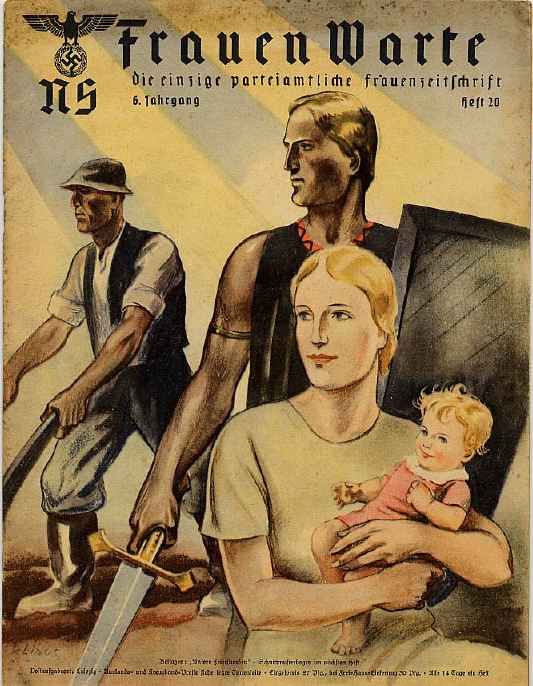
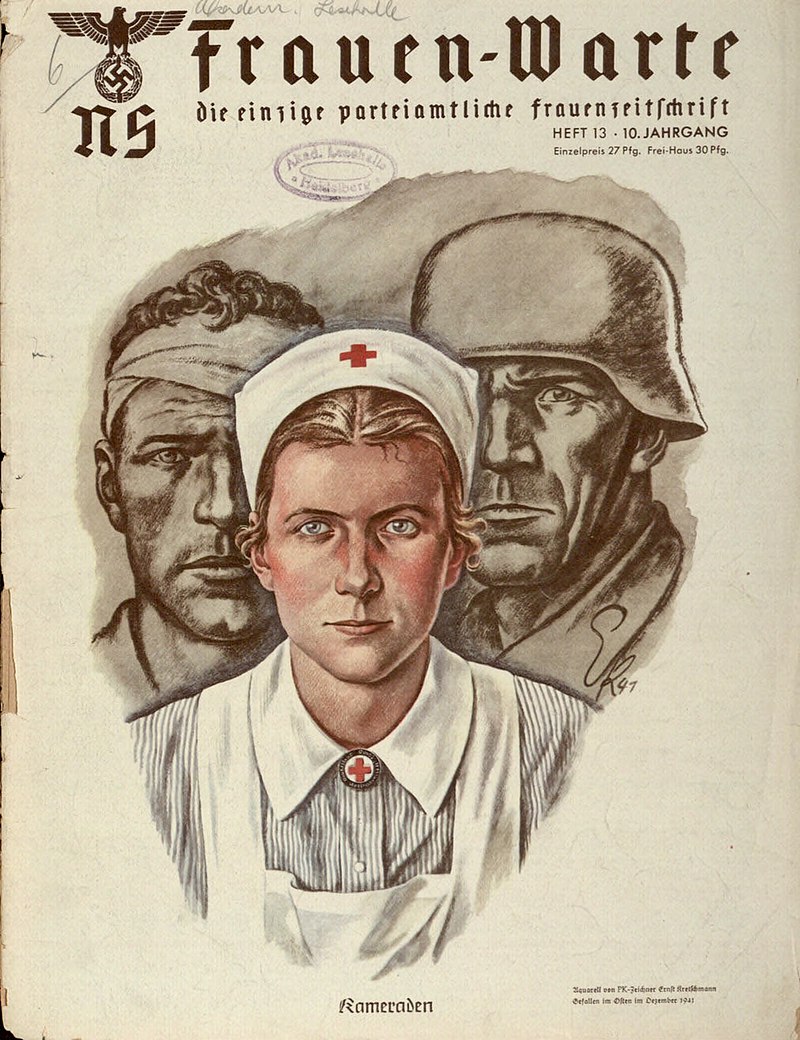
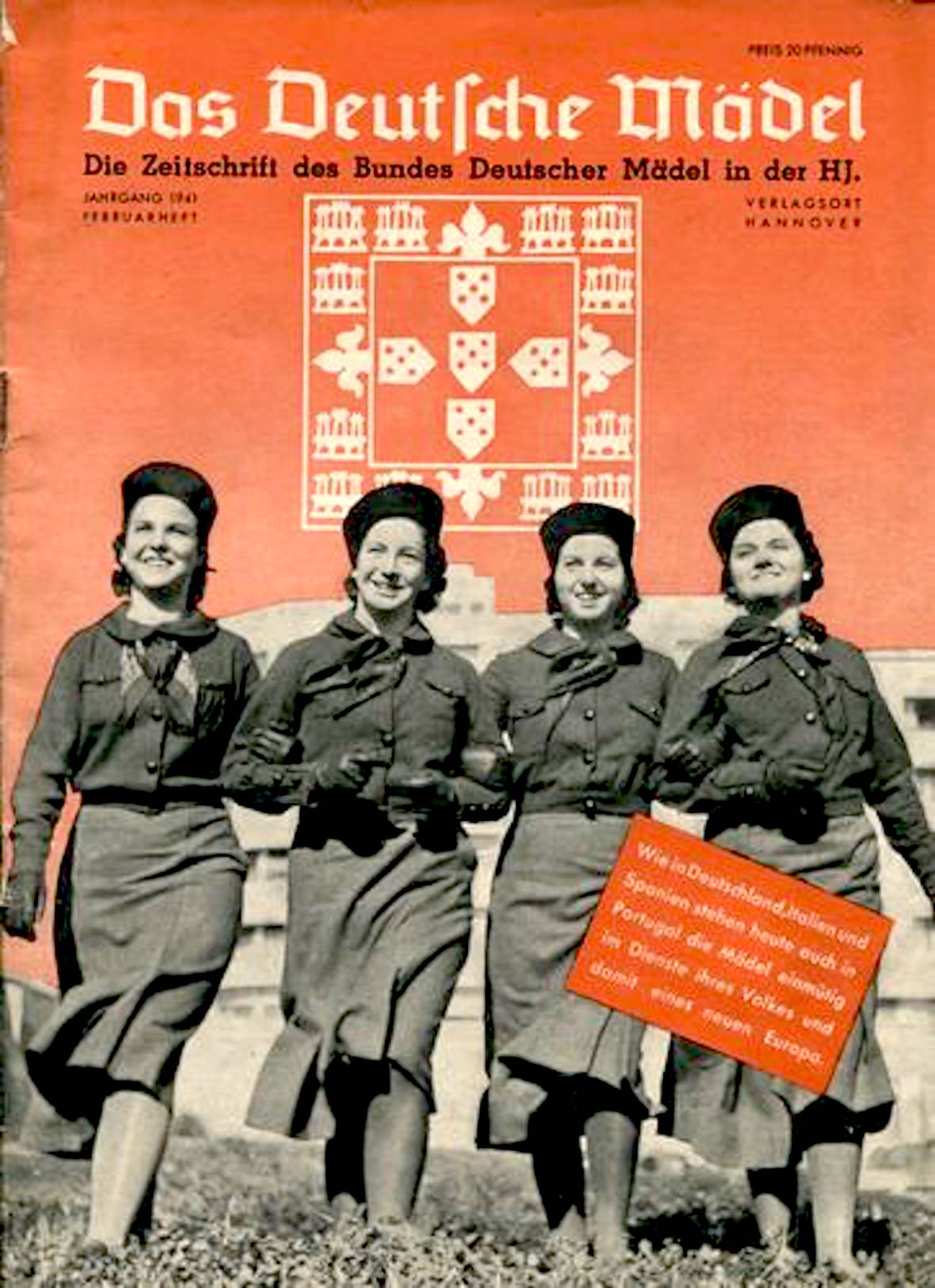
(right) Frauen-Warte No. 10, 1942. 'Comrades', propaganda drawing by Ernst Kretschmann, fallen on the Eastern Front in 1941.
◎「NS-Frauen-Warte (ナチ発行『国家社会主義女性モニター』誌)とDas Deutsche Mädel(『ドイツ女子』誌)」(サイト内リンク)
◎ドイツの人種衛生学(日本語名称は民族衛生学であ るが、言語は、ドイツ語のRassenhygiene、英語のRacial hygieneに該当するので、以下は人種衛生学という)
| Racial hygiene(Rassenhygiene) The term racial hygiene was used to describe an approach to eugenics in the early 20th century, which found its most extensive implementation in Nazi Germany (Nazi eugenics). It was marked by efforts to avoid miscegenation, analogous to an animal breeder seeking purebred animals. This was often motivated by the belief in the existence of a racial hierarchy and the related fear that "lower races" would "contaminate" a "higher" one. As with most eugenicists at the time, racial hygienists believed that the lack of eugenics would lead to rapid social degeneration, the decline of civilization by the spread of inferior characteristics. |
人種衛生または人種衛生学という言葉は、20世紀初頭にナチス・ドイツ
で最も大規模に行われた優生学(ナチス優生学)を表す言葉として使われている。これは、動物の繁殖家(ブリーダー)が純血種の動物を探すのに似ていて、混
血を避けようとする努力が特徴的である。これは、人種的なヒエラルキーが存在するという信念と、「低い人種」が「高い人種」を「汚染」してしまうという恐
怖からしばしば動機づけられていた。当時の優生学者がそうであったように、人種衛生学者も優生学の欠如は急速な社会退廃、すなわち劣った特性の拡散による
文明の衰退につながると考えていた。 ※この用語は、1895年にドイツの医学者アルフレッド・プレッツ(Alfred Ploetz)が 提唱したものである。 |
| Development The German eugenicist Alfred Ploetz introduced the term "racial hygiene" (Rassenhygiene) in 1895 in his Racial Hygiene Basics (Grundlinien einer Rassenhygiene). He discussed the importance of avoiding "counterselective forces" such as war, inbreeding, free healthcare for the poor, alcohol and venereal disease.[1] In its earliest incarnation it was more concerned by the declining birthrate of the German state and the increasing number of mentally-ill and disabled people in state-run institutions (and their costs to the state) than it was by the "Jewish question" and the "degeneration of the Nordic race" (Entnordung) which would come to dominate its philosophy in Germany from the 1920s to the Second World War.During the last years of the 19th century, the German racial hygienists Alfred Ploetz and Wilhelm Schallmayer regarded certain people as inferior, and they opposed their ability to procreate. These theorists believed that all human behaviors, including crime, alcoholism and divorce, were caused by genetics.[2] |
ドイツの優生学者アルフレッド・プレッツは、1895年に『人種衛生の
基本』(Grundlinien einer
Rassenhygiene)の中で「人種衛生」(Rassenhygiene)という言葉を紹介した。彼は、戦争、近親交配、貧困層への無料医療、アル
コール、性病などの「逆選択的な力」を避けることの重要性を論じた [1]。
初期には、1920年代から第二次世界大戦までのドイツでその思想を支配することになる「ユダヤ人問題」や「北欧人種の退化」(Entnordung)よ
りも、ドイツ国家の出生率の低下や国家運営の施設における精神疾患者や障害者の増加(およびその国家への負担)に関心を寄せていた。
19世紀末、ドイツの人種衛生学者アルフレッド・プレッツとヴィルヘルム・シャルマイヤーは、特定の人々を劣った存在とみなし、彼らの子孫を残す能力に反
対していた。これらの理論家は、犯罪、アルコール依存症、離婚など、人間のすべての行動は遺伝によって引き起こされると考えていた[2]。 |
| Nazi
Germany During the 1930s and 1940s, institutes in Nazi Germany studied genetics, created genetic registries and researched twins. Nazi scientists also studied blood, and developed theories on the supposed racial specificity of blood types, with the goal of distinguishing an "Aryan" from a Jew by examining their blood. In the 1940s, Josef Mengele, a doctor in the Schutzstaffel (SS), provided human remains that were taken from Auschwitz – blood, limbs and other body parts – to be studied at the institutes. Harnessing racial hygiene as a justification, the scientists used prisoners from Auschwitz and other concentration camps as test subjects for their human experiments.[2] Theories on racial hygiene led to an elaborate sterilization program, with the goal of eliminating what the Nazis regarded as diseases harmful to the human race. Sterilized individuals, reasoned the Nazis, would not pass on their diseases to their children. The Sterilization Law, passed on July 14, 1933, also known as the Law for the Prevention of Hereditarily Diseased Offspring, called for the sterilization of any person who had a genetically determined illness. The Sterilization Law was drafted by some of Germany's top racial hygienists, including: Fritz Lenz, Alfred Ploetz, Ernst Rudin, Heinrich Himmler, Gerhard Wagner and Fritz Thyssen. Robert N. Proctor has shown that the list of illnesses which the law targeted included "feeblemindedness, schizophrenia, manic depression, epilepsy, Huntington's chorea, genetic blindness, and 'severe alcoholism.'" The estimated number of citizens who were sterilized in Nazi Germany ranges from 350,000 to 400,000. As a result of the Sterilization Law, sterilization medicine and research soon became one of the largest medical industries.[2] In Nazi propaganda, the term "race" was often interchangeably used to mean the "Aryan" or Germanic "Übermenschen", which was said to represent an ideal and pure master race that was biologically superior to all other races.[3] In the 1930s, under eugenicist Ernst Rüdin, National Socialist ideology embraced this latter use of "racial hygiene", which demanded Aryan racial purity and condemned miscegenation. That belief in the importance of German racial purity often served as the theoretical backbone of Nazi policies of racial superiority and later genocide. The policies began in 1935, when the National Socialists enacted the Nuremberg Laws, which legislated racial purity by forbidding sexual relations and marriages between Aryans and non-Aryans as Rassenschande (racial shame). Racial hygienists played key roles in the Holocaust, the German National Socialist effort to purge Europe of Jews, Romani people, Slavs, Blacks, mixed race people, and physically or intellectually disabled people.[4] In the Aktion T4 program, Hitler ordered the execution of mentally-ill patients by euthanasia under the cover of deaths from strokes and illnesses.[2] The methods and equipment that had been used in the murder of thousands of mentally ill persons were then transferred to concentration camps, because the materials and resources needed to efficiently murder large numbers of people existed and had been proven successful. The nurses and the staff who had assisted and performed the killings were then moved along with the gas chambers to the concentration camps, which were being built in order to be able to replicate the mass murders repeatedly.[2] The doctors who carried out experiments on the prisoners in concentration camps specialised in racial hygiene and used the supposed science to back their medical experiments. Some of the experiments were used for general medical research, for example by injecting prisoners with known diseases to test vaccines or possible cures. Other experiments were used to further the Germans' war strategy by putting prisoners in vacuum chambers to see what could happen to pilots' bodies if they were ejected at a high altitude or immerse prisoners in ice water to see how long they would survive and what materials could be used to prolong life if worn by German pilots shot down over the English Channel.[5] The precursors of this notion were earlier medical experiments which German doctors performed on African prisoners of war in concentration camps in Namibia during the Herero and Namaqua Genocide.[6] A key aspect of National Socialism was the concept of racial hygiene and it was elevated to the primary philosophy of the German medical community, first by activist physicians within the medical profession, particularly amongst psychiatrists. That was later codified and institutionalized during and after the Nazis' rise to power in 1933, during the process of Gleichschaltung (literally, "coordination" or "unification"), which streamlined the medical and mental hygiene (mental health) profession into a rigid hierarchy with National Socialist-sanctioned leadership at the top.[7] The blueprint for Nazism's attitude toward other races was written by Erwin Baur, Fritz Lenz and Eugen Fischer and published under the title Human Heredity Theory and Racial Hygiene (1936). Source: https://en.wikipedia.org/wiki/Racial_hygiene |
1930年代から1940年代にかけて、ナチスドイツの研究所では遺伝
学の研究、遺伝子登録の作成、双子の研究などが行われた。ナチスの科学者たちは血液についても研究し、血液型を調べることで「アーリア人」と「ユダヤ人」
を区別することを目的に、人種的特異性を持つ血液型に関する理論を構築した。1940年代、親衛隊の医師ヨーゼフ・メンゲレは、アウシュビッツから持ち出
された人骨(血液、手足、体の一部)を研究所に提供し、研究させた。科学者たちは、人種的衛生を正当化するために、アウシュビッツや他の強制収容所の囚人
たちを人体実験の被験者としたのである[2]。 人種衛生に関する理論は、ナチスが人類にとって有害な病気と見なすものを排除する目的で、入念な不妊手術計画につながった。ナチスは、不妊手術を受けた者 は、その病気を子供に伝染させないという理屈を立てた。1933年7月14日に成立した「不妊手術法」は、「遺伝性疾患子孫防止法」とも呼ばれ、遺伝的に 決定された病気を持つ者はすべて不妊手術にすることを要求していた。不妊手術法は、ドイツのトップクラスの人種衛生学者たちによって起草されたものであ る。Fritz Lenz, Alfred Ploetz, Ernst Rudin, Heinrich Himmler, Gerhard Wagner, Fritz Thyssenなどである。ロバート・N・プロクターは、この法律が対象とした病気のリストには、「身体障害、精神分裂病、躁うつ病、てんかん、ハンチン トン病、遺伝的失明、『重度のアルコール中毒』」などが含まれていることを明らかにしている。ナチス・ドイツで不妊手術を受けた市民の数は、35万人から 40万人と推定されている。不妊手術法の結果、不妊手術の医療と研究はすぐに最大の医療産業のひとつとなった[2]。 ナチスのプロパガンダでは、「人種」という用語はしばしば「アーリア人」またはゲルマン人の「ユーベルメンヒェン」を意味するものとして交換可能に用いら れ、それは他のすべての人種よりも生物学的に優れている理想的で純粋な主人種を表すとされていた[3]。 1930年代に、優生学者エルンスト・リュダンのもと、国家社会主義の思想はこの後半の「人種衛生」の使用法を受け入れ、アーリア人種の純度を要求し混血 を禁止するものであった。ドイツの人種的純度の重要性に対するこの信念は、しばしばナチスの人種的優越政策とその後の大量虐殺政策の理論的バックボーンと して機能した。この政策は1935年に国家社会党がニュルンベルク法を制定し、アーリア人と非アーリア人の性的関係や結婚をRassenschande(人種の恥)として禁止し、人種的純度を法制化した ことから始まった。 人種衛生学者たちは、ヨーロッパからユダヤ人、ロマ人、スラブ人、黒人、混血人、身体・知的障害者を一掃しようとしたドイツ国家社会主義者の努力であるホ ロコーストにおいて重要な役割を果たした[4]。 Aktion T4計画では、ヒトラーは脳卒中や病死を装った安楽死による精神疾患患者の処刑を命じた[2]。 [何千人もの精神病患者の殺害に使用された方法と設備は、その後強制収容所に移された。なぜなら、大量の人々を効率的に殺害するのに必要な材料と資源が存 在し、成功が証明されていたからである。そして、殺人を支援し実行した看護師とスタッフは、ガス室とともに、大量殺人を繰り返し行うことができるように建 設されていた強制収容所に移されたのである[2]。 強制収容所で囚人に対する実験を行った医師たちは、人種衛生を専門とし、その医学的実験の裏付けとして想定される科学を利用した。例えば、ワクチンや可能 性のある治療法を試すために、既知の病気を囚人に注射するなど、一般的な医学研究のために使われた実験もあった。この考え方の先駆けは、ヘレロ族とナマク ア族の大量虐殺の際にドイツの医師がナミビアの強制収容所でアフリカ人の捕虜に対して行った医療実験であった[6]。 ※6:Lusane, Clarence (2002). Hitler's black victims: The historical experiences of Afro-Germans, European Blacks, Africans, and African Americans in the Nazi era. pp. 44, 217. ISBN 978-0415932950. 国家社会主義の重要な側面は、人種衛生の概念であり、それはまず、医学界の中の活動家医師、特に精神科医の間で、ドイツ医学界の主要な哲学に昇華されたの であった。それは後に、1933年にナチスが権力を握った後、Gleichschaltung(文字通り「調整」または「統一」)の過程で成文化され制度 化され、医療と精神衛生(メンタルヘルス)の専門家を、国家社会主義者が認可した指導者を頂点とする厳格な階層に合理化することになった[7]。 ナチズムの他民族に対する態度の青写真はエルヴィン・バウア、フリッツ・レンツ、オイゲン・フィッシャーによって書かれ、『人間遺伝論と人種衛生学』 (1936年)というタイトルで出版された。 出典は、https://en.wikipedia.org/wiki/Racial_hygiene 翻訳は、https://www.deepl.com/ja/translator |
| In Nazi propaganda, the
term
"race" was often interchangeably used to mean the "Aryan" or Germanic
"Übermenschen", which was said to represent an ideal and pure master
race that was biologically superior to all other races.[3] In the
1930s, under eugenicist Ernst Rüdin, National Socialist ideology
embraced this latter use of "racial hygiene", which demanded Aryan
racial purity and condemned miscegenation. That belief in the
importance of German racial purity often served as the theoretical
backbone of Nazi policies of racial superiority and later genocide. The
policies began in 1935, when the National Socialists enacted the
Nuremberg Laws, which legislated racial purity by forbidding sexual
relations and marriages between Aryans and non-Aryans as Rassenschande
(racial shame). |
ナチスのプロパガンダでは、「人種」という言葉はしばしば「アーリア
人」またはゲルマン人の「Übermenschen(優越人種)」
を意味するものとして交換可能として使われ、それは他のすべての人種よりも生物学的に優れた理想的で純粋な支配階級の象徴であるとされた[3]。1930
年代、優生学者エルンスト・リュディンのもと、国家社会主義思想はこの後者の「人種衛生」を取り入れ、アーリア人種の純度を求め、異種交配を非難するよう
になった。ドイツの人種的純度の重要性に対するこの信念は、しばしばナチスの人種的優越政策とその後の大量虐殺政策の理論的バックボーンとして機能した。
この政策は1935年に国家社会党がニュルンベルク法を制定し、アーリア人と非アーリア人の性的関係や結婚をRassenschande(人種の恥)とし
て禁止し、人種的純度を法制化したことから始まった。 |
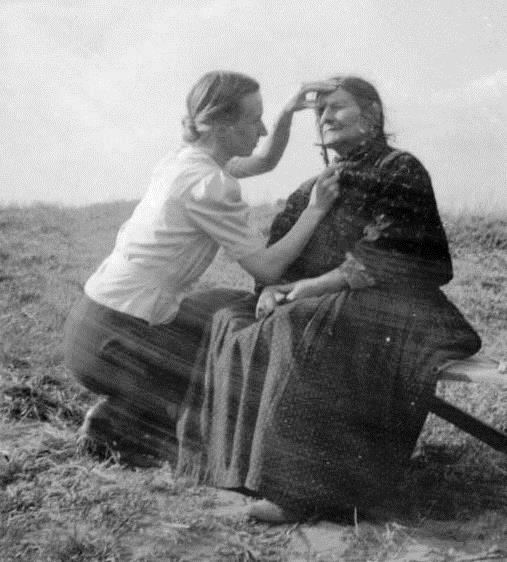 Eva
Justin checking the facial characteristics of a Romani woman, as part
of her "racial studies" Eva
Justin checking the facial characteristics of a Romani woman, as part
of her "racial studies" Eva Justin (23 August 1909 – 11 September 1966) was a German anthropologist who was active during the Nazi era. She specialised in scientific racism. Her work contributed to the Nazi crimes against the Sinti and Roma peoples. Born in Dresden in 1909, the daughter of a railroad official, Eva Justin served as an assistant to Nazi psychologist Robert Ritter.Justin originally trained as a nurse, and received her doctorate in anthropology from the University of Berlin in 1943, despite not having followed the normal university procedure to do so. Eugen Fischer mentored her through her doctoral thesis and final exams, and ethnologist Richard Thurnwald was a reviewer.[2] Justin was one of the first registered nurses to earn a PhD. Speaking Romani, she earned the trust of Roma and Sinti people. Her doctoral dissertation was titled "Lebensschicksale artfremd erzogener Zigeunerkinder und ihrer Nachkommen" ("Biographical destinies of Gypsy children and their offspring who were educated in a manner inappropriate for their species"). |
「人種研究
」の一環として、ロマ人女性の顔の特徴をチェックすエバ・ユスティン(Eva Justin) エヴァ・ユスティン(1909年8月23日 - 1966年9月11日)は、ナチス時代に活躍したドイツの人類学者である。専門は科学的人種差別。彼女の研究は、シンティとロマの人々に対するナチスによ る犯罪行為に貢献した。1909年、鉄道職員の娘としてドレスデンに生まれ、ナチスの心理学者ロベルト・リッターの助手を務めた。看護婦としての訓練を受 け、1943年に大学の正規の手続きを踏まずにベルリン大学で人類学の博士号を取得した。オイゲン・フィッシャーが博士論文と最終試験を指導し、民族学者 のリチャード・サーンワルドが査読を行った[2]。ロマ語を話す彼女は、ロマやシンティの人々から信頼を得ていた。博士論文のタイトルは 「Lebensschicksale artfremd erzogener Zigeunerkinder und ihrer Nachkommen」(「ジプシーの子供とその子孫の運命は、その種に不適切な方法で教育されたものである」)であった(→「エヴァ・ユスティンとロマ民族」)。 |
| After World War II After World War II, the idea of "racial hygiene" was not promoted. The racialist ideology was denounced as unscientific by many,[8] but there continued to be supporters and enforcers of eugenics even after there was widespread awareness of the nature of Nazi eugenics. After 1945, eugenics proponents included Julian Huxley and Marie Stopes, but they typically removed or downplayed the racial aspects of their theories.[9] |
第二次世界大戦後 第二次世界大戦後、「人種的衛生」の思想は推進されなくなった。人種主義的な思想は多くの人々によって非科学的であると非難されたが[8]、ナチスの優生 学の性質が広く認識された後も優生学の支持者や実行者は存在し続けた。1945年以降、優生学の支持者にはジュリアン・ハクスリーやマリー・ストップスが いたが、彼らは通常その理論の人種的側面を取り除くか軽視していた[9]。 |
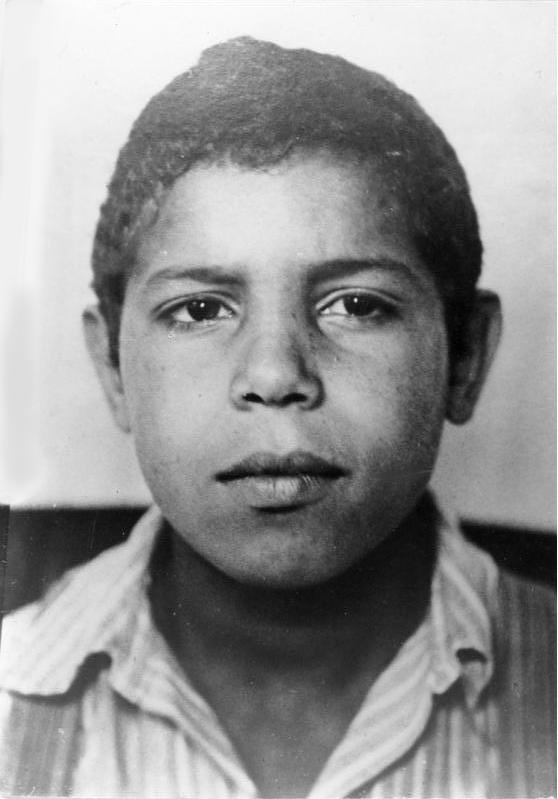 Young
Rhinelander who was classified as a Rhineland bastard and
hereditarily unfit under the Nazi regime as a result of his mixed race
heritage. Young
Rhinelander who was classified as a Rhineland bastard and
hereditarily unfit under the Nazi regime as a result of his mixed race
heritage.++++ Rhineland Bastard; Rhineland Bastard (German: Rheinlandbastard) was a derogatory term used in Nazi Germany to describe Afro-Germans, believed fathered by French Army personnel of African descent who were stationed in the Rhineland during its occupation by France after World War I. There is evidence that other Afro-Germans, born from unions between German men and African women in former German colonies in Africa, were also referred to as Rheinlandbastarde. After 1933, under Nazi racial theories, Afro-Germans deemed to be Rheinlandbastarde were persecuted. They were rounded up in a campaign of compulsory sterilization.[1] |
混血のため、ナチス政権下でラインラントの私生児(バスタード)とさ
れ、世襲不適格とされた青年のラインラント住民。 +++++ ラインラントバスタード;Rhineland Bastard(ドイツ語:Rheinlandbastard) は、第一次世界大戦後フランスに占領されていたラインラントに駐留していたアフリカ系のフ ランス軍兵士を父に持つとされるアフロジャーマンに対するナチスドイツの蔑称。また、アフリカの旧ドイツ植民地でドイツ男性・アフリカ女性との間に生まれ たアフロジャーマンもRheinlandbastardeと呼ばれた証拠がある。1933 年以降、ナチスの人種理論のもと、ラインラントバスタードとみなされたアフロ・ドイツ人は迫害されることになった。彼らは強制不妊手術のキャンペーンで一 網打尽にされた[1]。 |
| History The term "Rhineland Bastard" can be traced to 1919, just after World War I, when Entente troops, most of them French, occupied the Rhineland.[2] The British historian Richard J. Evans suggests the number of mixed-race children among them was not more than five or six hundred.[3] All World War I belligerents with colonial possessions went to great lengths to recruit soldiers from their colonies. Germany was the only one of the Central Powers with substantial overseas possessions; it used numerous non-white troops to defend its colonies. Regardless of German attitudes toward the indigenous inhabitants of German colonies, Germany's lack of control of the sea lanes would have made it nearly impossible for the German Army to bring any substantial number of colonial troops to European battlefields. Notwithstanding the exact circumstances, most Germans quickly came to view non-white Allied troops with disdain and were contemptuous of the Allies' willingness to use these troops in Europe.[citation needed] Germans across the political spectrum regarded the occupation as a national disgrace. Many considered all forms of collaboration and fraternization with the occupiers as immoral (if not illegal) treason. From the spring of 1920 onward, German newspapers frequently ran hysterical stories about the alleged "Black Horror on the Rhine", accusing Senegalese soldiers of routinely gang-raping thousands of German women and girls on a daily basis.[4] In the popular 1921 novel Die Schwarze Schmach: Der Roman des geschändeten Deutschlands (The Black Shame A Novel of Disgraced Germany) by Guido Kreutzer, he wrote that all mixed race children born in the Rhineland are born "physically and morally degenerate" and are not German at all.[5] Kreutzer also declared that the mothers of these children ceased to be German the moment they had sex with non-white men, and they could never join the Volksgemeinschaft.[5] As Germans considered the occupation to be carried out by "B-grade" troops (a notion that was drawn from colonial and racial stereotypes), their humiliation was heightened, increasing hostility toward the women and children in these unions.[6] In May 1920 the foreign minister of the new German government lodged a protest to his French counterpart stating that "we will accept the inferior discipline amongst your white troops if you will only rid us as fast as possible of this black plague".[7] In the Rhineland itself, local opinion of the troops was very different. The soldiers were described as "courteous and often popular", possibly because French colonial soldiers harbored less ill-will towards Germans than war-weary French occupiers.[8] In his book Mein Kampf, Adolf Hitler described children resulting from any kind of relationship to African occupation soldiers as a contamination of the white race "by Negro blood on the Rhine in the heart of Europe."[9] He thought that "Jews were responsible for bringing Negroes into the Rhineland, with the ultimate idea of bastardizing the white race which they hate and thus lowering its cultural and political level so that the Jew might dominate."[10] He also implied that this was a plot on the part of the French, since the population of France was being increasingly "negrified".[11] |
歴史 「ラインラント・バスタード」という言葉は、第一次世界大戦直後の1919年、フランス人を中心とした連合軍がラインラントを占領した時にまで遡ることが できる[2]。 イギリスの歴史家Richard J. Evansは、彼らの中の混血児は5、6百人にも満たなかったと示唆している[3]。 第一次世界大戦の交戦国のうち、植民地を保有していた国はすべて、植民 地から兵士を集めるために多大な努力を払っていた。ドイツは、中央列強の中で唯一、海外に大きな領土を有しており、植民地を守るために多くの非白人部隊を 使用した。ドイツが植民地の先住民に対してどのような態度をとるかは別として、ドイツがシーレーンを 支配していなかったため、ドイツ陸軍がヨーロッパの戦場に相当数の植民地兵を投入するこ とは不可能に近かったのであろう。正確な状況とは関係なく、ほとんどのドイツ人はすぐに非白人の連合軍を軽蔑の目で見るようになり、連合軍がヨーロッパで これらの軍隊を使おうとしていることを軽蔑した[citation needed]。 ドイツ人は政治的な観点から、この占領を国家の恥だと考えていた。多くの人々は、占領軍とのあらゆる形態の協力や友好関係を、(違法ではないにせよ)不道 徳な反逆行為とみなした。1920年春以降、ドイツの新聞は「ライン川の黒い恐怖」と称するヒステリックな記事を頻繁に掲載し、セネガル人兵士が日常的に 何千人ものドイツ人女性や少女を集団レイプしていると非難した[4]。 1921年の人気小説『Die Schwarze Schmach: クロイツァーは、ラインラントで生まれた混血児はすべて「肉体的にも道徳的にも退化して」生まれ、ドイツ人ではないと書いている[5]。また、これらの子 供の母親は、非白人男性とセックスした瞬間にドイツ人でなくなり、ヴォルクゲマインシャフトに入ることはできないと宣言している[5]。 1920年5月、ドイツ新政府の外務大臣はフランス側に対して「この黒い疫病をできるだけ早く取り除いてくれるなら、あなた方の白人部隊の劣悪な規律も受 け入れる」と抗議している[6]。 ラインラントでは、軍隊に対する地元の意見は非常に異なっていた。兵士たちは「礼儀正しく、しばしば人気がある」と評されており、おそらく戦争で疲弊した フランスの占領軍よりもフランスの植民地兵士の方がドイツ人に対して悪意を抱いていなかったためであろう[8]。 アドルフ・ヒトラーは著書『我が闘争』の中で、アフリカの占領軍兵士と の何らかの関係から生まれた子供を「ヨーロッパの中心であるライン川における黒人の血による」白人種の汚染と表現した[9]。彼は「ユダヤ人は、彼らが嫌 う白人種を幼稚化し、それによってその文化と政治のレベルを下げ、ユダヤ人が支配できるようにするという究極の考えのもとに、ライン川に黒人を持ち込んだ 責任がある」と考え[10]、フランスの人々がますます「黒人化」していたのでこれはフランスの側の陰謀であるとほのめかしもしている[11]。 |
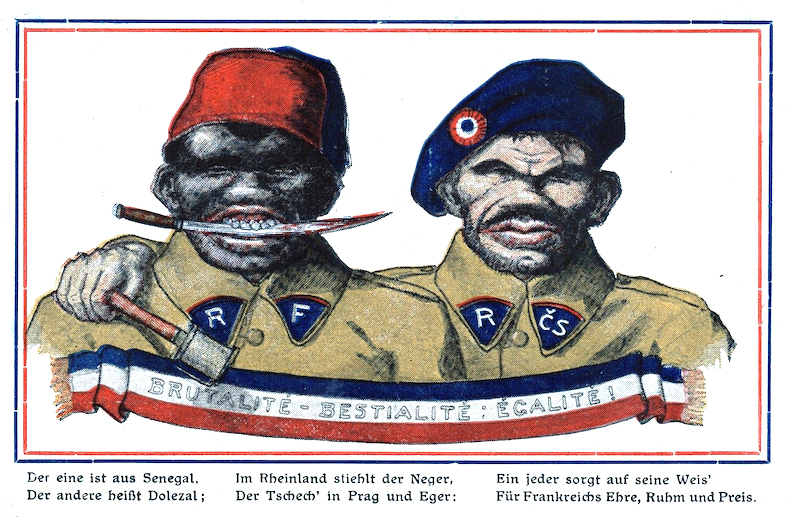 "Brutality, Bestiality, Equality". German postcard
sent in January
1923. A Senegalese of the French army is represented alongside a Czech
soldier. "Brutality, Bestiality, Equality". German postcard
sent in January
1923. A Senegalese of the French army is represented alongside a Czech
soldier. |
「残虐性・獣性・平等」(自由・博愛・平等のパロディ)。1923年1
月に送られたドイツの絵葉書。フランス軍のセネガル人がチェコ人兵士と並んで表象されている。→ここからナチの政権掌握の10年前のワイマール時代にも、
フランス軍の人種平等主義に対するドイツの側からの人種偏見や黒人憎悪が存在したことがわかる。チェコスロバキアに対する憎悪は、ナチスドイツのチェコ支
配において(ハイドリヒ暗殺への報復の住民殺戮など)複雑な影をおとす。 |
| Colonial legacy Most of the tiny multiracial population in Germany at that time were children of German settlers and missionaries in the former German colonies in Africa and Melanesia, who had married local women or had children with them out of wedlock. With the loss of the German colonial empire after World War I, some of these colonists returned to Germany with their mixed-race families.[3] While the black population of Nazi Germany was small – 20–25,000 in a population of over 65 million[12] – the Nazis decided to take action against those in the Rhineland. They despised black culture, which they considered inferior, and sought to prohibit "traditionally black" musical genres such as American jazz as being "corrupt negro music".[13] No official laws were enacted against the black population, or against the children of mixed parentage, as they were born from marriages and informal unions that preceded the Nuremberg laws of September 1935. The latter prohibited "miscegenation". However, future sexual relations and "mixed marriages", between so-called "Aryans" and "non-Aryans" were banned. In addition, persons of mixed parentage were deprived completely of the right to marry. The government established the Sonder Kommission Nr.3 ("Special Commission 3") and appointed Eugen Fischer, of the Kaiser Wilhelm Institute of Anthropology, Human Heredity, and Eugenics, to head it. He was tasked with preventing procreation and reproduction by "Rhineland Bastards". It was decided that anyone so deemed would be sterilized under the 1933 Law for the Prevention of Hereditarily Diseased Offspring.[1] The program began in 1937, when local officials were asked to identify all "Rhineland Bastards" under their jurisdiction.[1] All together, some 800 children of mixed parentage were arrested and sterilized. According to Susan Samples, the Nazis went to great lengths to conceal their sterilization and abortion program.[1] Representation in other media Esi Edugyan's novel, Half Blood Blues (2011), features an Afro-German jazz trumpet player in Berlin, who plays with African Americans, a German Jew, and a white German. He is swept up by the Nazis as a "Rhineland Bastard". Where Hands Touch (2018) directed by Amma Asante features protagonist Leyna (portrayed by Amandla Stenberg) who was conceived in the post-WWI occupation of Germany to a black French soldier and a white German woman. [14] Source: https://en.wikipedia.org/wiki/Rhineland_Bastard |
植民地時代の遺産 当時ドイツにいたごく少数の多民族は、アフリカやメラネシアの旧ドイツ植民地にいたドイツ人入植者や宣教師が現地の女性と結婚したり、婚外子として産んだ りした子供たちがほとんどであった。第一次世界大戦後のドイツ植民地帝国の喪失に伴い、これらの植民地の人々の中には混血の家族を連れてドイツに戻ってき た者もいた[3]。 ナチスドイツの黒人人口は、人口6500万人以上に対して2〜25万人と少なかったが[12]、ラインラントの人々に対する行動を起こすことにした。彼ら は黒人文化を劣ったものと見なし、アメリカのジャズのような「伝統的な黒人」の音楽ジャンルを「腐敗した黒人の音楽」として禁止しようとした[13]。黒 人人口や、1935年9月のニュルンベルク法に先立つ結婚や非公式の結合から生まれた混合親族の子どもたちに対しては、公式の法律は制定されなかった。後 者は「混血」を禁止していた。しかし、いわゆる「アーリア人」と「非アーリア人」の間の将来の性的関係や「混血結婚」は禁止された。さらに、混血の人は結 婚する権利を完全に奪われた。 政府は「第3特別委員会」を設置し、カイザー・ヴィ ルヘルム人類学・人類遺伝学・優生学研究所(KWI-A)のオイゲン・フィッシャーをその長に任命した。彼の任務は 「ラインラントのバスタード」による子作りや繁殖を防ぐことであった。そう判断された者は、1933年の「遺伝性疾患子孫の防止に関する法律」に基づいて 不妊手術を受けることが決定された[1]。 このプログラムは1937年に開始され、地方の役人は管轄内のすべての「ラインラント・バスタード」を確認するよう求められた[1]。 合計で約800人の混血児が逮捕され、不妊手術が施された。スーザン・サンプルによれば、ナチスは不妊手術と中絶のプログラムを隠すために多大な労力を費 やしたという[1]。 他のメディアにおける表現 エシ・エドゥギャンの小説『Half Blood Blues』(2011年)は、ベルリンでアフリカ系アメリカ人、ドイツ系ユダヤ人、白人ドイツ人と共演するアフロ・ジャズ・トランペット奏者を主人公と している。彼は「ラインラント・バスタード」としてナチスに振り回される。 アンマ・アサンテ監督『Where Hands Touch』(2018)は、第一次世界大戦後のドイツ占領下で、黒人のフランス兵と白人のドイツ人女性との間に宿ったレイナ(Amandla Stenbergが演じる)を主人公としている。[14] 翻訳は、https://www.deepl.com/ja/translator |
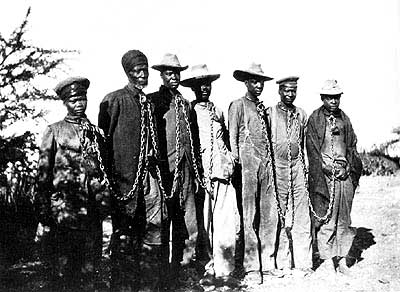 Herero
chained by German captors during the 1904 rebellion in
South-west Africa Herero
chained by German captors during the 1904 rebellion in
South-west Africa |
1904年の南西アフリカの反乱で、ドイツ人捕虜に鎖でつながれたヘレ
ロ人。ヘレロ戦争:ヘレロおよびナマ虐殺(ヘレロ・ナマクア
ぎゃくさつ、ドイツ語: Völkermord an den Herero und
Nama)は、ドイツ領南西アフリカ(現・ナミビア)においてドイツ帝国が先住民族に対して行った虐殺。アフリカ分割の動きの中の1904年から1908
年[1]にかけて行われ、20世紀最初のジェノサイド(虐殺)と考えられている。アフリカ分割に加わったドイツ帝国による南部アフリカ侵攻で土地を追われ
た先住民族のヘレロ族は1904年1月12日、サミュエル・マハレロ(英語版)の指揮の下、ドイツ人への無差別攻撃を開始した(ホッテントット蜂起)。こ
れに対してドイツは8月、ロタール・フォン・トロータ将軍の指揮でこれを破り(en:Battle of
Waterberg)、三方から包囲して、カラハリ砂漠(英: Omaheke
Desert)に追い込み、英領ベチュアナランドを目指して脱出した途上で多くが渇きのために死んだ。ベチュアナランドに辿り着いたのは1000人以下
だった。10月にはナマクア族[2]も蜂起したが同様の結果に終わった。ドイツは先住民を強制収容所へ収容したり強制労働に従事させたりした。結果、戦後
の人口統計からみて、約6万人のヘレロ族(全人口8万人のうち、80%)、1万人のナマクア族(全人口2万人のうち50%)が死亡した。ヘレロ族の死者数
は2万4000人~最大10万人とする推計もある[3]。この虐殺の特徴は、一つは餓死であり、もう一つはナミブ砂漠に追いやられたヘレロ族とナマクア族
の使用する井戸に毒を入れたことによる中毒死である。 |
◎カイザー・ヴィルヘルム人類学・人類遺伝学・優生学研究 所(KWI-A)(Kaiser Wilhelm Institute of Anthropology, Human Heredity, and Eugenics) 【→カイザー・ヴィルヘルム科学振興機構】
◎ドイツ人種衛生協会(Gesellschaft für Rassenhygiene; German Society for Racial Hygiene , 1905-1945)
アルフレッド・プレッツ(Alfred Ploetz, 1860-1940)によって設立。最初の会員は、アルフレッド・プレッツに加えて、プレッツの精神科医であり義理の兄弟であるエルンスト・リューディ ン、プレッツの幼なじみのゲアハルト・ハウプトマン、作家のウィルヘルム・ベルシェ、衛生学者のマックス・フォン・グルーバー、医師のウィルヘルム・シャ ルマイヤー、医師のアグネス・ブルームThurnwald、探検家Wilhelm Filchner、弁護士Anastasius Nordenholz、動物学者のLudwig PlateとKonradGünther 、植物学者のErwin Baur、[2]医師のヴィルヘルム・ヴァインベルク、衛生学者のIgnaz Kaup、社会民主主義の社会衛生学者のAlfredGrotjahn。ベルリンの後、ミュンヘン、フライブルク、シュトゥットガルトに他の地元のグルー プが設立された。動物学者のエルンスト・ヘッケル、遺伝学者のアウグスト・ヴァイスマン、産婦人科医のアルフレッド・ヘーガーが名誉会員であった。
協会(学会)は国際人種衛生学会に改名され、ベルリ ンのアーウィンバウア、ミュンヘン、フライブルクの有名な人間遺伝学者フリッツ・レンツとオイゲン・フィッシャー、そして1910年からシュトゥットガル トに支部が設立される。これには遺伝学者のヴィルヘルム・ヴァインベルクが含まれていた。[2]この組織は、フランシス・ガルトン()の下で英国優生学教育協会と提携しており、スウェーデ ン、米国、オランダにも支社が20世紀初頭に設立された。[3] 1924年、この組織はドイツ人種衛生学会に改名された。
協会を代表する理念は、1911年の国際衛生博覧会 の後、ますます人気を博した。この組織は、科学的なテーマとして「人種衛生」を確立したいと考え、ドイツでの実施に大きく貢献した。ナチスの優生学の理念 の採用と政治的人種的措置に関する具体的な協議の両方で、協会は、アクションT4「安楽死」の不可欠な部分であった、アドルフ・ヒトラーが率いるナチス政 権のプログラムである「遺伝病根絶法(Gesetz zur Verhütung erbkranken Nachwuchses)Law for the Prevention of Hereditarily Diseased Offspring」 のような法令に直接影響を及ぼした。1933年までに、人種衛生学会には1,300人の会員がおり、その多くは学者であり、ナチ党の高官もいた。
Schafft, Gretchen Engle: "From Racism to Genocide: Anthropology in the Third Reich". University of Illinois Press. 2004.
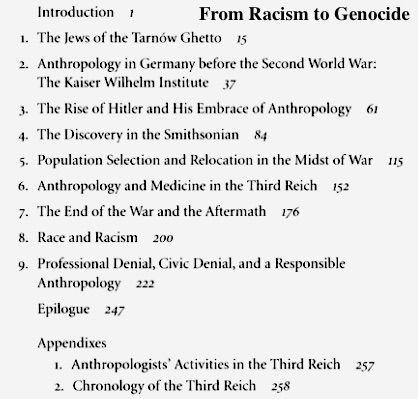
Description of From racism to genocide
: anthropology in the Third Reich.
In paperback for the first time, From Racism to Genocide is an
explosive, richly detailed account of how Nazi anthropologists
justified racism, developed practical applications of racist theory,
and eventually participated in every phase of the Holocaust. Using
original sources and previously unpublished documentation, Gretchen E.
Schafft shows the total range of anti-human activity from within the
confines of a particular discipline. Based on seven years of archival
research in the United States and abroad, the work includes many
original photos and documents, most of which have never before been
published. It uses primary data and original texts whenever possible,
including correspondence written by perpetrators. The book also reveals
that the United States was not merely a bystander in this research, but
instead contributed professional and financial support to early racial
research that continued through the first five years of Hitler's regime.
Table of Contents
The Jews of the
Tarnow ghetto (Sep. 8, 1939-January 18, 1945)
Anthropology in Germany before the Second World War: The Kaiser Wilhelm
Institute.
The rise of Hitler his embrace of anthropology
The discovery in the Smithsonian
Population selection and relocation in the midst of war
Anthropology and medicine in the Third Reich
The end of the war and the aftermath
Race and racism
Professional denial, civic denial and a responsible anthropology
●1940年以降は、それまで蜜月の関係にあったア メリカの優生学とナチの優生学は、反ユダヤ主義との結びつきが明らかになることを通して険悪になる(キュール 1999:172)
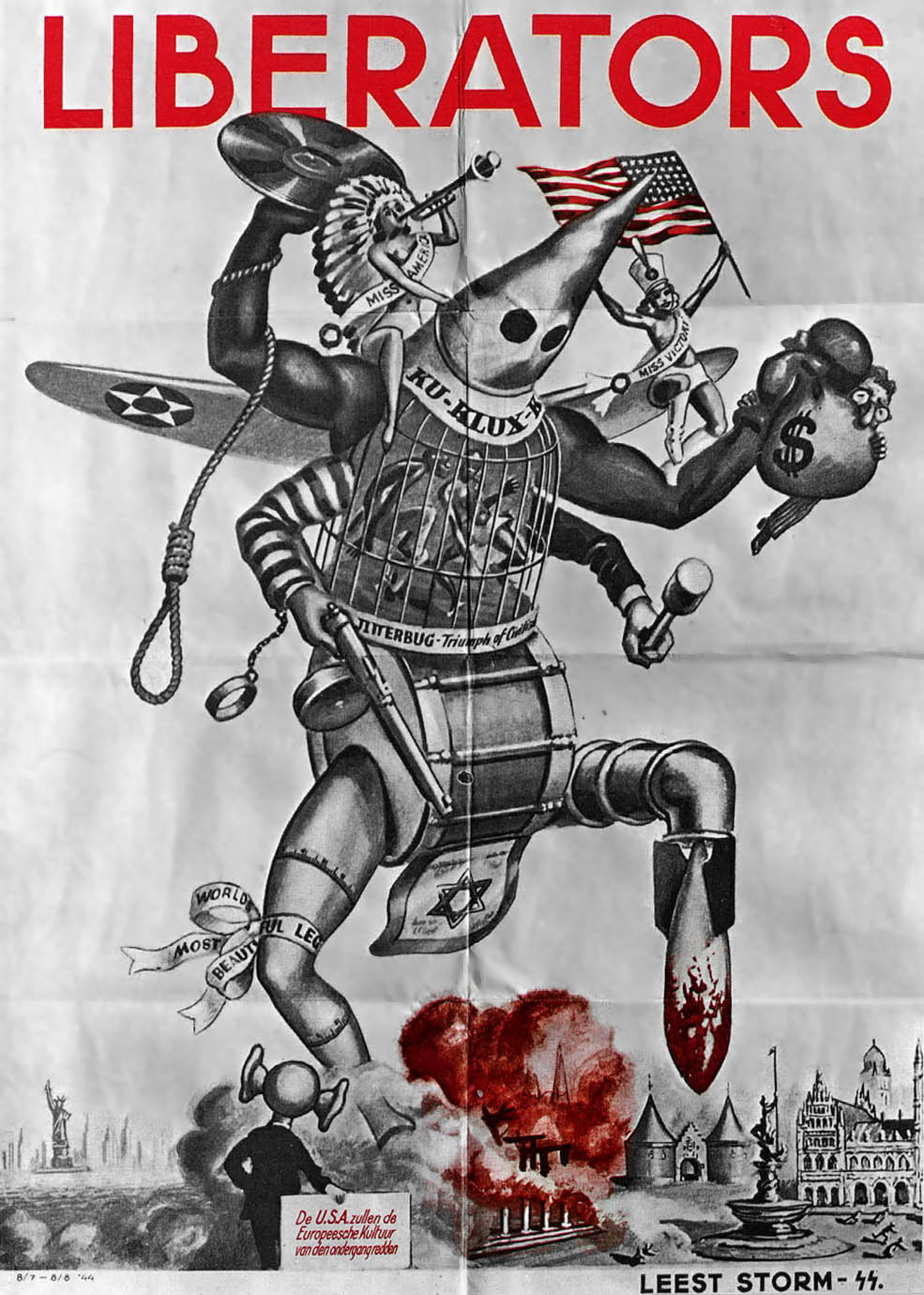
「リベレーター」つまり自由解放者アメリカの虚像。 奴隷制度、KKKによるリンチ、拝金主義、そしてユダヤ人が、ヨーロッパの町を爆撃により破壊している メッセージが読み取れる。アメリカのイメージは人間と昆虫(脚が三対6本)のハイブリッドとして表現されている。中央左下にある「アメリカ合衆国は、別の 回廊からヨーロッパ文化を救済に来るだろう」(オランダ語)*から、恐らくナチスドイツ親衛隊(SS)により1944年当時占領下にあった当地で配布され たと思われる。* De U.S.A. zullen de Europeesche Kultuur van den ondergang redden.(→出典:「「南京虫」という語彙はもう忘れましょう」)
●ナチ人種理論(Nazi racial theories)は教育とプロパガンダを通して、徹底的に教育される。
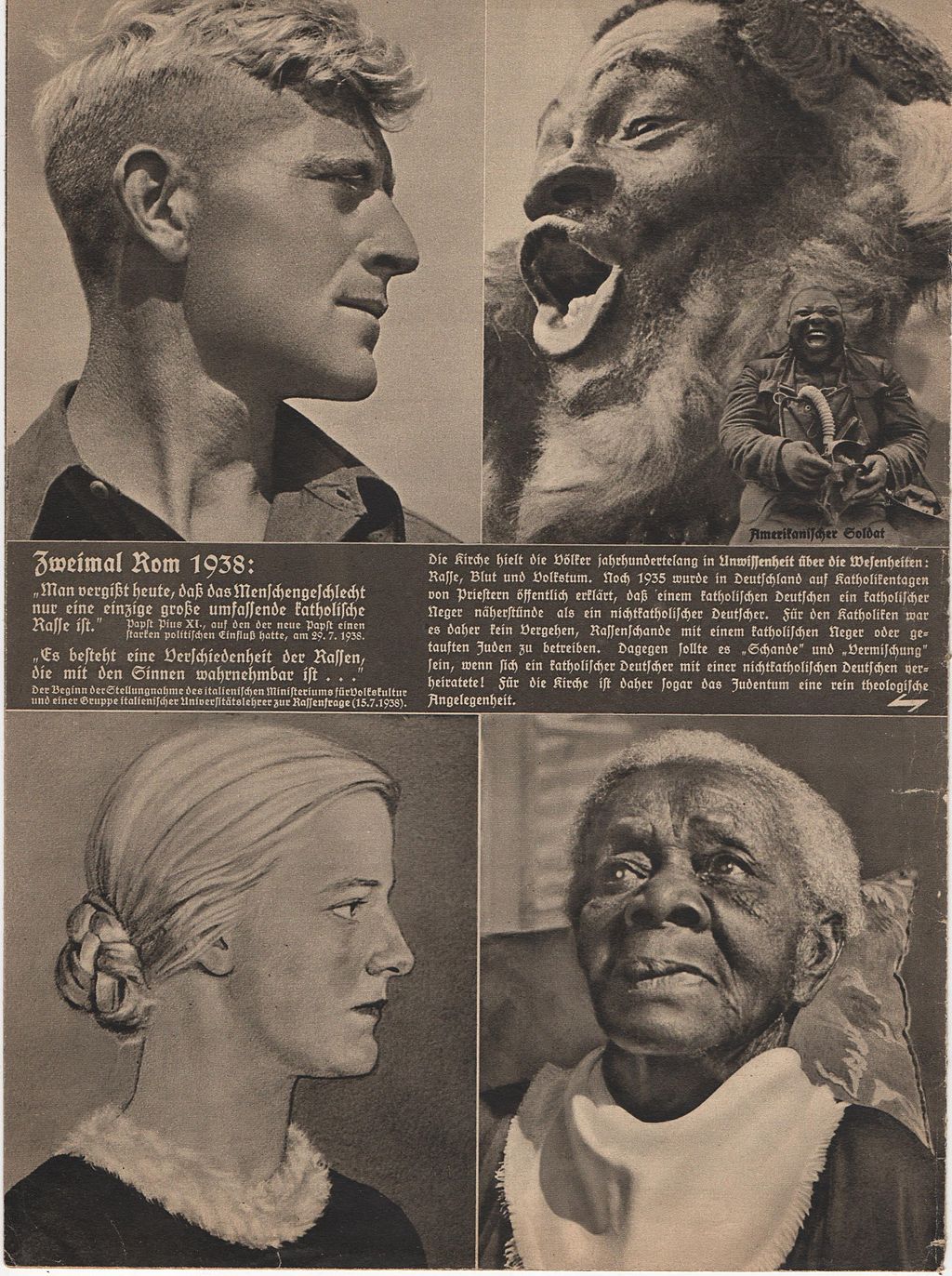
Nazi propaganda showing the difference between Aryan Germans and non-Aryan black people(from )
| Racialist ideology → Racial
policy of Nazi Germany |
レイシズム・イデオロギー |
| Different Nazis offered a range
of pseudo-religious or pseudoscientific arguments to prove that the
Aryan race was superior to all other races. The central dogma of Aryan
superiority was espoused throughout the party by officials who used
scientific racist propaganda. A person deemed to be a "subhuman" would be stripped of all of his/her rights, he or she would be treated like an animal, his or her life would be considered a Lebensunwertes Leben (life unworthy of living) and he or she would only be considered fit for enslavement and extermination.[153][154][155][156] In schools, Nazi ideology taught German youths to understand the differences which supposedly existed between the Nordic German "Übermenschen" and the "ignoble" Jewish and Slavic "subhumans".[157] An illustration of this ideology was described in the 1990s by a German-Jewish woman, who vividly recalled hearing Nazis march by her home in central Germany in the mid-1930s while they were singing, "When Jewish blood squirts from my knife."[158] A biography of Lise Meitner says "In the Reichstag the NSDAP deputies stretched their arms in the Nazi salute and sang their party anthem, the Horst Wessellied: "SA marching... Jew blood in the streets".'[159] Richard Walther Darré, Reich Minister of Food and Agriculture from 1933 to 1942, popularized the expression "Blut und Boden" ("Blood and Soil"), one of the many terms in the Nazi glossary ideologically used to enforce popular racism in the German population. There were many academic and administrative scholars of race who all had somewhat divergent views of racism, including Alfred Rosenberg and Hans F. K. Günther.[160] Fischer and Lenz were appointed to senior positions overseeing the policy of racial hygiene. The Nazi state used such ideas about the differences between European races as part of their various discriminatory and coercive policies which culminated in the Holocaust. The first (1916) edition of the American eugenicist Madison Grant's popular book The Passing of the Great Race[161] classified Germans as being primarily Nordic,[162] but the second edition, published after the US had entered WWI, reclassified the now-enemy power as being dominated by "inferior" Alpines, a tradition which was echoed in Harvard Professor of Anthropology Carleton Coon's book The Races of Europe (1939).[163] Günther's book stated that the Germans are definitely not a fully Nordic people, and it also divided them into Western (Mediterranean), Nordic, Eastern (Alpine), East Baltic and Dinaric races. Hitler himself was later to downplay the importance of Nordicism in public for this very reason. The simplistic tripartite model of Grant which divided Europeans into only Alpine, Mediterranean, and Nordic, Günther did not use, and erroneously placed most of the population of Hitler's Germany in the Alpine category, especially after the Anschluss. This has been used to downplay the Nordic presence in Germany. Gunther considered Jews an "Asiatic race inferior to all European races".[79] J. Kaup led a movement opposed to Günther. Kaup took the view that a German nation, all of whose citizens belonged to a "German race" in a populationist sense, offered a more convenient sociotechnical tool than Günther's concept of an ideal Nordic type to which only a very few Germans could belong. Nazi legislation identifying the ethnic and "racial" affinities of the Jews reflects the populationist concept of race. Discrimination was not restricted to Jews who belonged to the "Semitic-Oriental-Armenoid" and/or "Nubian-African/Negroid" races, but was directed against all members of the Jewish ethnic population.[165] The German Jewish journalist Kurt Caro, who emigrated to Paris in 1933 and served in the French and British armies,[166] published a book under the pseudonym Manuel Humbert unmasking Hitler's Mein Kampf in which he stated the following racial composition of the Jewish population of Central Europe: 23.8% Lapponoid race, 21.5% Nordic race, 20.3% Armenoid race, 18.4% Mediterranean race, 16.0% Oriental race.[167] By 1939 Hitler had abandoned Nordicist rhetoric in favor of the idea that the German people as a whole were united by distinct "spiritual" qualities. Nevertheless, Nazi eugenics policies continued to favor Nordics over Alpines and other racial groups, particularly during the war when decisions were being made about the incorporation of conquered peoples into the Reich. The Lebensborn program sought to extend the Nordic race.[168][169][170] In 1942 Hitler stated in private: I shall have no peace of mind until I have planted a seed of Nordic blood wherever the population stand in need of regeneration. If at the time of the migrations, while the great racial currents were exercising their influence, our people received so varied a share of attributes, these latter blossomed to their full value only because of the presence of the Nordic racial nucleus.[13] Hitler and Himmler planned to use the SS as the basis for the racial "regeneration" of Europe following the final victory of Nazism. The SS was to be a racial elite chosen on the basis of "pure" Nordic qualities.[171][172] Addressing officers of the SS-Leibstandarte "Adolf Hitler" Himmler stated: The ultimate aim for those 11 years during which I have been the Reichsfuehrer SS has been invariably the same: to create an order of good blood which is able to serve Germany; which unfailingly and without sparing itself can be made use of because the greatest losses can do no harm to the vitality of this order, the vitality of these men, because they will always be replaced; to create an order which will spread the idea of Nordic blood so far that we will attract all Nordic blood in the world, take away the blood from our adversaries, absorb it so that never again, looking at it from the viewpoint of grand policy, Nordic blood, in great quantities and to an extent worth mentioning, will fight against us.[173] |
さまざまなナチスが、アーリア人が他のすべての人種より優れていること
を証明するために、さまざまな疑似宗教的または疑似科学的な議論を提供しました。アーリア人の優位性という中心的なドグマは、科学的な人種差別的プロパガ
ンダを用いる幹部によって党全体に信奉された。 亜人」とみなされた者はすべての権利を剥奪され、動物のように扱われ、その人生はLebensunwertes Leben(生きるに値しない人生)とみなされ、奴隷や絶滅に適しているとしかみなされないとされた[153][154][155][156]。 学校では、ナチスのイデオロギーはドイツの若者に、北欧系ドイツ人の「超人」と「無価値な」ユダヤ人やスラブ人の「亜人」の間に存在するとされる差異を理 解するように教えていた[157]。 [このイデオロギーの実例は、1990年代にあるドイツ系ユダヤ人女性によって語られている。彼女は、1930年代半ばにドイツ中部の自宅のそばでナチス が「ユダヤの血が私のナイフから吹き出るとき」と歌いながら行進するのを聞いたことを鮮明に覚えている[158] リゼ・マイトナーの伝記には「帝国議会でNSDAP下院議員がナチの敬礼で腕を伸ばし党歌のホルスト・ヴェッセリートが歌われる」とある。「SAが行進 し... ユダヤ人の血が流れる」[159]。 1933年から1942年まで帝国食糧農業大臣であったリヒャルト・ワルター・ダレは、「血と土(Blut und Boden)」という表現を広めたが、これはナチの用語集の中でドイツ国民に一般的な人種差別を強制するために思想的に使われた多くの用語の1つである。 アルフレッド・ローゼンベルクやハンス・F・K・ギュンターなど、人種差別についていくらか異なる見解を持つ多くの学者や行政学者がいた[160]。 フィッシャーとレンツは人種的衛生政策を監督する上級職に任命されていた。ナチス国家は、ヨーロッパ人種の違いに関するこのような考え方を、ホロコースト に結実したさまざまな差別的・強制的政策の一環として利用した。 アメリカの優生学者マディソン・グラントの人気書籍『偉大なる人種の通過』の初版(1916年)[161]は、ドイツ人を主に北欧人として分類していた が、アメリカが第一次世界大戦に参戦した後に出版された第二版は、今や敵国となったドイツを「劣った」アルプス人に支配されていると再分類し、この伝統は ハーバード大学の人類学教授カールトン・クーンの著書『ヨーロッパの人種(1939)』に反響している[163]。 ギュンターの著書では、ドイツ人は完全な北方民族ではないことは間違いないとし、さらに西方(地中海)、北方、東方(アルプス)、東バルト、ディナールの 各民族に分けた上で、「ドイツ人は北方民族ではない」とした。ヒトラー自身は、まさにこの理由から、後に公の場で北方民族の重要性を軽視するようになっ た。ヨーロッパ人をアルプス系、地中海系、北欧系だけに分ける単純化されたグラントの三部モデルは、ギュンターは使わず、特にアンシュルスの後、ヒトラー のドイツの人口のほとんどを誤ってアルプス系に位置づけた。このことは、ドイツにおける北欧系の存在を軽視するために利用されてきた。グンターはユダヤ人 を「すべてのヨーロッパ人種に劣るアジア系人種」と考えていた[79]。 J. カウプはギュンターに反対する運動を率いていた。カウプは、国民全員が人口論的な意味での「ドイツ民族」に属するドイツ国家は、ごく少数のドイツ人だけが 属することができる理想的な北欧型のギュンターの概念よりも便利な社会技術的な道具を提供するという見解を示していた。ナチスによるユダヤ人の民族的、 「人種的」なつながりを特定する法律は、人口論的な人種概念を反映している。差別は「セム・東洋・アルメノイド」や「ヌビア・アフリカ・ネグロイド」の人 種に属するユダヤ人に限定されるものではなく、ユダヤ人の民族的集団のすべての構成員に対して行われた[165]。 1933年にパリに移住し、フランス軍とイギリス軍に従軍したドイツ系ユダヤ人ジャーナリストのクルト・カロは、マニュエル・ハンベルトというペンネーム でヒトラーの『我が闘争』をカモフラージュするを出版し、その中で中央ヨーロッパのユダヤ人の人種構成について次のように述べている:ラポノイド人種 23.8%、北欧人種21.5%、アルメノイド人種20.3%、地中海人種18.4%、東欧人種16.0%[167]。 1939年までにヒトラーは北欧主義のレトリックを放棄し、ドイツ国民全体が明確な 「精神的」資質によって結合されているという考えを支持していた。それにもかかわらず、ナチスの優生学政策はアルプス人や他の人種よりも北欧人を優遇し続 け、特に戦争中に征服した民族を帝国に編入することが決定されたときには、とくにその傾向が強かった。(ヒムラー指導の)レーベンスボルン計画は北欧人種 を拡大することを目指した[168][169][170]。 1942年、ヒトラーは私的な場でこう述べている。 私は、国民が再生を必要としているところならどこでも、北欧の血の種を植えるまで は、心の安らぎを得ることはできない。移住の際、偉大な人種の流れがその影響力を行使している間、我々の国民が非常に多様な属性を受け取っ ていたとすれば、これらの属性は北欧人種の核が存在することによってのみその価値を最大限に開花させたのである[13]。 ヒトラーとヒムラーは、ナチズムの最終的な勝利の後に、ヨーロッパの人 種的な「再生」の基礎としてSSを使用することを計画していた。親衛隊は「純粋な」北欧人の資質に基づいて選ばれた人種的なエリートである べきだった[171][172]。 SS-ライプシュタールテ「アドルフ・ヒトラー」部隊の将校を前にして、ヒムラーはこう述べている。 「私が親衛隊の総統であった11年間の究極の目的は、常に同じであっ た。北欧の血という概念を広めて、世界中の北欧の血を引きつけ、敵から血を奪い、吸収して、大方針の観点から見て、北欧の血が大量に、言及するに値する程 度に、二度と我々に敵対しないようにすることである」[173]。 [173] |
| Racist Philosophy Philosophers and other theoreticians participated in the elaboration of Nazi ideology. The relationship between the German philosopher Martin Heidegger and Nazism has remained a controversial subject in the history of philosophy, even today. According to the philosopher Emmanuel Faye, Heidegger said of Spinoza that he was "ein Fremdkörper in der Philosophie", a "foreign body in philosophy"—Faye notes that Fremdkörper was a term which belonged to the Nazi glossary,[174][175] and not to classical German. However, Heidegger did to a certain extent criticize racial science, particularly in his Friedrich Nietzsche lectures, which reject biologism in general, while generally speaking even Heidegger's most German nationalist and pro-Nazi works of the early 30s, such as his infamous Rectorial address, lack any overtly racialized language. Thus it is problematic to connect Heidegger with any racial theory. Carl Schmitt elaborated a philosophy of law praising the Führerprinzip and the German people, while Alfred Baeumler instrumentalized Nietzsche's thought, in particular his concept of the "Will to Power", in an attempt to justify Nazism. |
哲学者をはじめとする理論家たちがナチスのイデオロギーの練り上げに参
加した。ドイツの哲学者マルティン・ハイデガーとナチズムの関係は、今日でも哲学史の中で論争の的となっている。哲学者のエマニュエル・フェイによれば、
ハイデガーはスピノザを「ein Fremdkörper in der
Philosophie」、「哲学における異物」であると述べている-フェイは、Fremdkörperはナチの用語集に属する用語であり、古典ドイツ語
に属しているわけではない[174][175]と述べている。しかし、ハイデガーは、特に生物学一般を否定する『フリードリヒ・ニーチェ』の講義におい
て、ある程度は人種科学を批判していた。一方、一般的に言えば、ハイデガーの30年代前半の最もドイツナショナリスト的で親ナチの著作、例えば悪名高い『学長講演』
でさえ、人種を露骨に表現したものではない。したがって、ハイデガーをいかなる人種論とも結びつけることは問題である。カール・シュミットは総統のプリン
ツィプとドイツ国民を賛美する法哲学を展開し、アルフレッド・バウムラーはニーチェの思想、特に「力への意志」の概念をナチズムを正当化するために利用し
た。 |
| Propaganda and implementation of racial
theories → Propaganda
in Nazi Germany and Racial
policy of Nazi Germany |
人種理論の宣伝と実行 |
| The Nazis developed an elaborate
system of propaganda which they used to diffuse their racial theories.
Nazi architecture, for example, was used to create the "new order" and
improve the "Aryan race". The Nazis also believed that they could use
Sports to "regenerate the race" by exposing supposedly inferior
peoples, namely the Jews, as slovenly, sedentary and out-of-shape. One
of the basic motivations of the Hitler Youth, founded in 1922, was the
training of future "Aryan supermen" and future soldiers who would
faithfully fight for the Third Reich. In 1920 the Nazi Party announced that only Germans of “pure Aryan descent” could become party members and if the person had a partner then he or she also had to be a "racially pure" Aryan. Party members could not be related either directly or indirectly to a so-called "non-Aryan".[176] Nazi Party members and members of other Nazi organisations had to ask permission from their regional party official (Gauleiter) if they wanted to marry people who had two grandparents who were members of the “Czech, Polish, or Magyar Volk groups”.[19] German farmers who were Nazi Party members were prohibited from marrying Czechs and Poles in order to “preserve the purity” of their “own racial and ethnic foundations” to prevent the latter from marrying into German farmsteads.[177] German cinema was used to promote racist theories, under the direction of Goebbels' Propagandaministerium. The German Hygiene Museum in Dresden diffused racial theories. A 1934 poster of the museum shows a man with distinctly African features and reads, "If this man had been sterilized there would not have been born ... 12 hereditarily diseased."(sic).[178] According to the current director Klaus Voegel, "The Hygiene Museum was not a criminal institute in the sense that people were killed here," but "it helped to shape the idea of which lives were worthy and which were worthless."[178] Nazi racial theories were soon translated into legislation, the most notable pieces of legislation were the July 1933 Law for the Prevention of Hereditarily Diseased Offspring and the 1935 Nuremberg Laws. The Aktion T4 euthanasia program, in which the Kraft durch Freude (KdF, literally "Strength Through Joy") youth organization participated, targeted people accused of representing a danger of "degeneration" towards the "Deutsche Volk". Under the race laws, sexual relations between Aryans (cf. Aryan certificate) and non-Aryans known as Rassenschande ("race defilement") became punishable by law.[179][180] To preserve the "racial purity" of the German blood, after the beginning of the war the Nazis extended the race defilement law to include all foreigners (non-Germans).[89] Despite the laws against Rassenschande, German soldiers raped Jewish women during the Holocaust.[181] The Nazi regime called for all German people who wanted to be citizens of the Reich to produce proof of Aryan ancestry. Certain exceptions were made when Hitler issued the "German Blood Certificate" for those people who were classified to be of partial Aryan and Jewish ancestry by the race laws. During World War II, Germanization efforts were carried out in Central and Eastern Europe in order to cull those people of "German blood" who lived there. This started with the classification of people into the Volksliste. Those people who were considered German and selected for inclusion in the Volksliste were either kidnapped and sent to Germany to undergo Germanization, or they were killed in order to prevent "German blood" from being used against the Nazis.[182] In regions of Poland, many Poles were either murdered or deported in order to make room for Baltic Germans[183] induced to emigrate after the pact with the USSR.[184] Efforts were made to identify people of German descent with Nordic traits from pre-war citizens of Poland. If these individuals passed the screening process test and were considered "racially valuable", they were abducted from their parents to be Germanized and then sent to Germany to be raised as Germans. Those children who failed such tests might be used as subjects in medical experiments or as slave laborers in German industry.[185][186] Western countries, such as France, were treated less harshly because they were viewed as racially superior to the "subhuman" Poles who were to be enslaved and exterminated, though they were not considered as good as full Germans were; a complex of racial categories was boiled down by the average German to mean that "East is bad and West is acceptable."[187] Still, extensive racial classification was practiced in France, for future uses.[188] https://en.wikipedia.org/wiki/Nazi_racial_theories#Racialist_ideology |
ナチスは精巧なプロパガンダのシステムを開発し、彼らの人種理論を広め
るために利用した。例えば、ナチスの建築は「新秩序」を作り出し、「アーリア人種」を改良するために使われた。ナチスはまた、スポーツを利用して、劣等民
族とされるユダヤ人を、だらしなく、定住的で、体型の崩れたものとして暴露することによって、「民族を再生」させることができると考えていました。
1922 年に設立されたヒトラーユーゲント の基本的な動機の一つは、将来の「アーリア人のスーパーマン」と第三帝国のために忠実に戦う未来の兵士を
育てることであった。 1920年、ナチス党は「純粋なアーリア系」のドイツ人だけが党員になれると発表し、その人にパートナーがいる場合は、その人も「人種的に純粋な」アーリ ア人でなければならないとした。党員はいわゆる「非アーリア人」と直接的にも間接的にも関係を持つことはできなかった[176]。ナチ党員や他のナチス組 織のメンバーが「チェコ、ポーランド、マジャール民族」のメンバーの祖父母を持つ人々と結婚したい場合、地域の党役員(Gauleiter)に許可を得な ければならなかった[177]。 [19] ナチ党員であるドイツの農民は、「自らの人種的・民族的基盤」の「純粋さを保つ」ために、チェコ人やポーランド人がドイツの農家に嫁ぐことを防ぐために結 婚を禁じられていた[177]。 ドイツ映画は、ゲッベルスの宣伝省(Propagandaministerium)の指示のもと、人種差別理論を促進するために利用された。ドレスデンの ドイツ衛生博物館は人種差別の理論を広めていた。1934年の同博物館のポスターには、アフリカ人特有の特徴を持つ男が描かれており、「もしこの男が不妊 手術を受けていたら、...生まれなかっただろう」と書かれている。12人の遺伝性疾患者」(sic)と書かれている[178]。現館長のクラウス・ フェーゲルによれば、「衛生博物館はここで人が殺されたという意味で犯罪機関ではなく」、「どの命が価値があり、どの命が価値がないかという考えを形成す るのに貢献した」[178]。 ナチスの人種理論はすぐに立法化され、最も注目すべきは1933年7月の「遺伝性疾患子孫の防止に関する法律」と1935年の「ニュルンベルク法」であっ た。青年団「Kraft durch Freude(KdF)」が参加した安楽死プログラム「Aktion T4」は、「ドイツ民族」の「退化」の危険を代表することができるとされた人々を対象としたものであった。人種法の下で、アーリア人(アーリア人証明書を 参照)と非アーリア人との性的関係はRassenschande(「人種の穢れ」)として知られ、法律で罰せられるようになった[179][180]。 ドイツ人の血の「人種的純度」を維持するために、戦争開始後、ナチスは人種穢染(Rassenschande)の概念をすべての外国人(非ドイツ人)を含 むように拡大した[89]。 ラッセンシャンド=人種汚染(Rassenschande)を禁止する 法律にもかかわらず、ドイツ兵はホロコーストの際にユダヤ人女性を強姦していた[181]。※Ravitz, Jessica. "Silence lifted: The untold stories of rape during the Holocaust". CNN. ナチス政権は、帝国の市民となることを望むすべてのドイツ人に対して、アーリア人の先祖であることを証明する書類を提出するよう求めていた。人種法によっ てアーリア人とユダヤ人の部分的な先祖を持つと分類された人々に対して、ヒトラーが「ドイツ血統証明書」を発行した際には、一定の例外が設けられた。 第二次世界大戦中、中・東欧に住む「ドイツ人の血」を持つ人々を淘汰するために、ドイツ化が進められた。これは、人々を「フォルクスリスト」に分類するこ とから始まった。ポーランドの地域では、ソ連との協定後に移住を誘導されたバルト海系ドイツ人[183]を受け入れるために、多くのポーランド人が殺害さ れるか国外追放された[184]。これらの人々がスクリーニングプロセスのテストに合格し、「人種的に価値がある」と見なされた場合、彼らはドイツ化され るために両親から誘拐され、ドイツ人として育てられるためにドイツに送られた。そのようなテストに不合格となった子どもたちは、医学実験の被験者として、 あるいはドイツの産業における奴隷労働者として利用されることもあった[185][186]。 フランスなどの西側諸国は、完全なドイツ人ほど優秀ではないと考えられていたものの、奴隷にされ絶滅させられることになっていた「人間以下」のポーランド 人よりも人種的に優れていると見られていたため、それほど厳しく扱われていなかった; 人種分類の複合体は、平均的ドイツ人によって「東は悪く、西は受け入れられる」という意味に煮詰められた[187] それでも、フランスでは将来の使用のために大規模な人種的分類が行われていた[188]。 |
| https://en.wikipedia.org/wiki/Nazi_racial_theories#Racialist_ideology |
https://www.deepl.com/ja/translator |
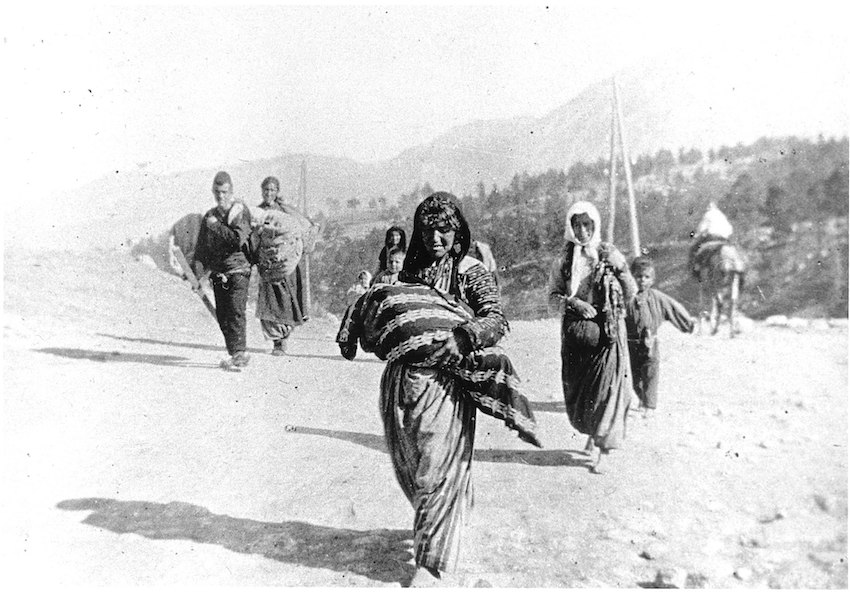
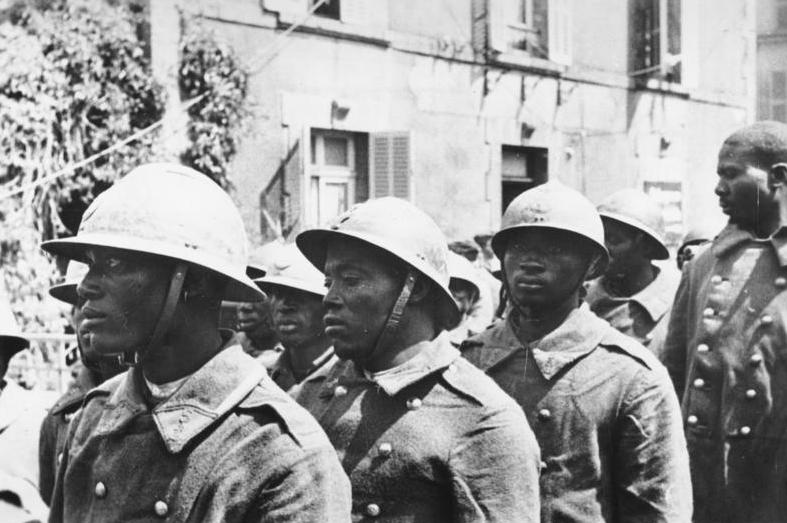
Many German
nationalists in Weimar Republic viewed the Armenian
genocide
as a justified act. This was related to their categorization
of Armenians as an inferior race.[164]31 December 1914/ Around 120,000
prisoners of war from French-ruled Africa were captured by the Germans
in 1940 during the Battle of France. Unlike other French captives, they
were not deported to Germany for fear of racial defilement.
◎関係人名リスト(バーリーとヴィッパーマン「人種 主義国家ドイツ」1991より)
| アイケEicke, Theodor |
カウツキーKautsky, Karl |
ザイス・インクワルトSeyss
Inpuart, Arthur |
ダーウィンDarwin, Charles |
ナーゲルNagel, Hans | ハイドリヒHeydrich,
Reinhard |
ブルクデルファーBurgdorfer,
Friedrich |
マイジンガーMeisinger, Josef | ヤーンJahn, F. |
ワイルダー Wilder, Billy |
| アイヒマンEichmann, Adolf |
カウフマンKauffmann, Theodore |
シェーフアーSchafer, Hans-Dieter |
タキトゥスTacitus |
ニーキッシュ Niekisch Ernst | ハイネ Heyne, Heinrich |
ブルゼジンスキBrzezinski, Zbigniew |
マイナーズMeiners, Christoph |
ライLey, Robert |
ワグナー Wagner, Gerhard |
| アインシュタインEinstein, Arbert |
カーテル Catel, Werner |
シェプス Schoeps, H.J. |
ターナ— Turner, Henry Ashby |
ニーチェ Nietzsche, Friedrich | ハイム Heim, Susanne |
フレンケルFraenkel Ernst |
マイネッケMeinecke, Friedrich |
ライテマイヤーReitemeier, Johann Georg
Friedrich |
|
| アステルAstel, Karl |
ガル Gall, Franz Joseph |
シェーンボームSchoenbaum, David |
ダレDarre, Walther |
ニッテイNitti, Francesco | ハウプトマンHauptmann, Gerhart |
プレッツPloetz, Alfred |
マークス Marks, Sally |
ラィヒライトナ—Reichle1tner, Franz |
|
| アブッシュ Abusch, Alexander |
カールスCarus, Carl Gustav |
シェーレンベルクSchellenberg, Walter |
ダーレンドルフDahrendorf, Ralf |
ネーベNebe, Arthur |
ハルトルHartl, Albert |
プレミンガーPreminger, Otto |
マッコMacco Hans |
ラヴァターLavater, J.K |
|
| アーベル Abel Wilhelm |
カレオCalleo, David |
シャーデSchade, Heinrich |
チェンバレンChamberlain, Houston
Stewart |
ノイマンNeumann, Franz |
バウム Baum, Herbert |
フロイト Freud, Sigmund |
マルクスMarx, Karl |
ラウシュニングRauschning, Hermann |
|
| アリーAly, Gotz |
ガレンGalen, Clemens August Graf von |
シャハトSchacht, Hjalmar |
ツァンダーZander, Elsbeth |
ノルテNolte Ernst |
ピエチェフスキーPieczewski, Josef |
ブロッホBloch, Ernst . |
ミュラー Millier Bishop |
ラートRath, Ernst von |
|
| イーリーEley, Geoff |
カント Kant, Immanuel |
シャルフScharf, Werner |
ティエリーThierry, Augustin |
ヒトラーHitler, Adolf |
ブロシャートBroszat, Martin |
ミュラーMillier, Hermann |
ラングLang, Fritz |
||
| ヴァイスマン Weissmann, August |
カンペルCamper, Pieter |
シャルマイヤーSchallmeyer, Wilhelm |
デイナーDiner, Dan |
ヒムラーHimmler, Heinrich |
ヘーゲルHegel , G.W.F. |
ムッカーマンMuckermann, Hermann |
ランゲLange, Herbert |
||
| ヴァンシタートVansittart, Robert |
ギュット Giitt, Arthur |
シュヴェーデ=コベルグ Schwede-Coburg,Franz |
ティーラックThierack Otto |
ヒルグルーバーHillgruber, Andreas |
ベックBeck, Ludwig |
ムッソリーニMussolini, Benito |
ランダウ Landau、Felix |
||
| ベウジェッツ |
ギュンター Giinther, Hans |
シュヴェンガーSchwemnger, Hermann |
ディールスDiels, Rudolf |
ヒルゲンフェルトHilgenfeldt, Erich |
ヘッケル Haeckel Ernst |
メイソンMason, Thimothy W. |
ランツLanz, Jorg (von Liebenfels) |
||
| ヴェルネットVaemet |
ギュンターGiinther, H.F.K. (Rassen) |
シュタウフェンベルクStauffenberg, Claus
Graf Schenk von |
デインターDinter, Artur |
ヒルシュフェルトHirschfeld, Magnus |
へスHoess, Rudolf |
メストル Maistre, Joseph de |
リッターRitter, Robert | ||
| ヴェーラーWheler, Hans-Ulrich |
グストロフGustloff Wilhelm |
シュタングルStangl, Franz |
テイラ一Taylor. A.J.P. |
ヒルデブラントHildebrand, Klaus |
ベタース Boeters, Gerhard |
メッツカーMezger, Edmund |
リッターRitter, Gerhart |
||
| ヴェルメイユ Vermeil, Edmond |
クライシッヒKreyssig, Lothar |
シュティルマーSturmer, Michael |
テルボーフェンTerboven, Josef |
ヒルファデイングHilferding, Rudolf |
へフターHeffter Moritz Wilhelm |
メンゲレMengele, Josef |
リーベルマンLiebermann, Max | ||
| ヴォルカーWolker, Ludwig |
グライフェルトGreifelt, Uhich |
シュトゥッカートStuckart, Wilhelm |
トゥホルスキTucholsky, Kurt |
ビンデインクBinding, Karl |
べーベルBebel, August |
メンツェル Menzel, Karl Adolf |
リーベンナイナ― Liebenneiner, Wolfgang |
||
| ヴットケ Wuttke Heinrich |
クランツKranz, Wilhelm |
シュトラィヒャーStreicher, Julius |
トライチュケTreitschke, Heinrich von |
ヒンデンブルクHindenburg, Paul von |
ヘルダーHerder, Johann Gottfried |
メンネッケMennecke, Friedrich |
リルケRilke, Rainer Mana |
||
| エーベルトEbert, Friedrich |
グーリアンGurian, Wardemar |
シュペーア Speer, Albert |
フィヒテFichte, Johann Gottlieb |
ヘルベルトHerbert, Ulrich |
モーゲンソーMorgenthau, Henry |
ルクセンブルクLuxemburg, Rosa |
|||
| エッツエンバッハーEschenbacher, Max |
グリンスパンGrynszpan, Hershel |
シュライビャーSchleicher, Kurt von |
フィッシャーFischer, Eugen |
ヘンチェル Hentschel, Willibald |
モムゼンMommsen, Hans |
ルストRust, Bernhard |
|||
| エンゲルスEngels, Friedrich |
クルップKrupp, Friedrich Alfred |
シュルツェ Schultze, Hagen |
フィッシャーFischer, Fritz |
ポイカート Peukert Detlev |
レームRohm Ernst |
||||
| オッテン Otten, Karl |
クレンペルラーKlemperer, Victor |
シュレックSchreck, Josef |
フェーダーFeder, Gottfried |
ボウラーBouhler, Philipp |
レンツLenz, Fritz |
||||
| オーバーハウザー Oberhauser Josef |
グロートヤーン Grotjahn, Alfred |
ショルッ=クリンクScholtz-Klink, Gertrud |
フエリーチェFelice, Renzo De |
ホックBock, Gisela |
ローゼンベルクRosenberg, Alfred |
||||
| オーバーレンダーOberlander, Theodor |
グロスGross, Walter |
シーラッハSchiracht, Bardur von |
フェルシュアーVerschuer, Otomar
Freiherr von |
ホッヘ Hoche, Alfred |
ロートRoth, Karl-Heinz |
||||
| オーレンドルフOhlendorf Otto |
グロブケ Globke Hans |
スターリン Stalin, Joseph |
フォルスターForster, Johann Georg |
ボナパルトBonaparte, Louis Napoleon |
ロートフェルス Rothfels Hans |
||||
| グロボツニクGlobocnik, Odilo |
スペンサーSpencer, Herbert |
ブラウン Braune, Paul |
ボナルトBonald, Louis de |
ロッレ Lorre, Peter |
|||||
| ゲーリングGoring, Hermann |
スミグイ・リッツ Smigly -Ridz, Marshal |
ブラックBrack, Viktor |
ホモルカ Homolka,Oskar |
ルーディン
Ernst Rüdin |
|||||
| ゲッベルスGoebbels, Joseph |
ゼルテSeldte, Franz |
ブラックボーンBlackboum, David |
ポールPohl, Oswald |
||||||
| ゲルケGerke, Achim |
ストウルツォ Sturzo, Luigi | ブラッハーBracher, Karl Dietrich |
ボルケナウBorkenau, Franz |
||||||
| ゲルデラーGoerdeler, Carl |
フランクFrank, Hans |
ボルマンBormann, Martin |
|||||||
| ゴットシェウスキGottschewski, Lydia |
ブラント Brandt, Karl |
ホーンHohn, Reinhard |
|||||||
| ガイヤーGeyer, Kurt |
フリックFrick, Wilhelm |
||||||||
| ゴビノーGobineau, Arthur de |
フリッチェFritsch, Freiherr Werner von |
||||||||
| コールKohl, Helmut |
フリードベルクFriedberg, Marian |
||||||||
| ゴールトンGalton, Francis |
フリードリヒFriedrich, Carl Joachim |
||||||||
| コンティConti, Leonardo |
フリードレンダーFriedleder Saul |
||||||||
| ブリューニング Brlining, Heinrich |
●旧クレジット:「ナチ人種衛生学・ナチ優生学の時
代, the Nazi Eugenics, and Racial Hygine」を「第三帝国における人種衛生学, Racial Hygiene
in the Third Reich」に変更した(2022.10.03)
Links
リンク
文献(和書)
文献(要所)
その他の情報



++
Copyleft,
CC, Mitzub'ixi Quq Chi'j, 1996-2099